|
|
Post by codystarbuck on Apr 14, 2020 15:30:20 GMT -5
Between 1896 and 1929, Peter Kurten committed a series of petty crimes, acts of violence against animals, assaults, rapes, violent stabbings and stranglings and acts of brutal murder, primarily in the Dusseldorf area. He was turned in by his wife (with his agreement) and arrested at gunpoint, tried, convicted and sentenced to death by beheading. He was known as "The Vampire of Dusseldorf" for licking the wounds of some of his victims. Their ages ranged from age 5 to an elderly woman. Friedrich Haarman, known as the butcher of Hanover, sexually assaulted, murdered, mutilated and dismembered 24 men and boys, between 1918 and 1928. Carl Grobmann was arrested in 1921, beside a dead woman and is believed to have murdered an unknown number of women, over 20 years and butchered their bodies, possibly selling pieces as meat. Karl Denke murdered and cannibalized vagrants from 1903-1923. Aside from all occuring in Germany and of horrific violence and depravity, what unites these cases as the killers were caught by the police, who had created a central homicide division, run by Ernst Gennat. Gennat joined the police force in 1904, quickly becoming a detective. He was largely responsible for the creation of a homicide division and putting together the investigative teams. He has a clearance rate of 94% and developed the earlest techniques in the profiling of serial killers, coining the term (serienmorder, in German) for the criminal. he worked directly on the cases of Kurten and Haarmann. He served as head of the head of homicide and director of police under Imperial Germany, the Weimar Republic and the Nazi Third Reich. Turn of the century Germany was a place of stark divides in wealth and conditions worsened after WW1, with the German defeat and the economic chaos that accompanied the war reparations and the Great Depression. Kurten and Haarman were known to have brutal childhoods, with severe beatings, sexual molestation, violence against animals and humans, with years of systematic abuse and violent acts. Police grappled with these cases, while dealing with sensationalistic press and political pressures. This is the environment that informed the creation and production of Fritz Lang's cinematic masterpiece M. The film tells the tale of a child murderer on the loose, with a reward of 10,000 marks for information that leads to his capture. Young Elsie Beckmann leaves school, bouncing her ball along the pavement anad against walls and street lamps. She encounters a shadowy man, who whistles "In the Hall of the Mountain King, " from Grieg's Peer Gynt... The man walks with her and buys her a balloon from a blind street vendor. They walk away and we see Elsie's mother looking out frantically for her daughter. We see the ball roll accross a patch of grass and the balloon fly into telephone lines. The body of Elsie is later discovered and the hysteria begins. The killer sends an anonymous letter to the police, promising more murders. They scrutinize the letter for fingerprints and analyze the handwriting. The police search the city and go after the criminal world with a vengeance, putting pressure on them to help turn up the kliller. The criminal underworld sets the beggars and prostitutes to watch children for signs of the killer scrutinizing them. The killer spots a young girl and befriends her. The same blind street vendor recognizes the whistled tune and alerts one of the criminals. He follows, but is afraid of losing the man. He takes chalk and writes a large "M" on his hand, fakes tripping and marks the shoulder of the killer. Street beggars follow and the killer notices and takes refuge in an empty office building. The criminals surround the building and capture and torture watchmen for information. Then, they hunt for the killer. The police also descend upon the area, but the criminals find the kilelr first and drag him away. he is brought before a tribunal, in the basement of a distillery and tried for his crimes. he cries out that he cannot help himself, that he can't control the monster within him. You see even some of the jury, hardened criminals, feel some sympathy for him, except for the fact that he killed children. he is sentenced to death; but, the police arrive before the sentence is carried out. The film ends with Elsie's mother, in mourning, crying out that the must do better to watch their children. Lang's purpose in doing the film was to make a social criticism about how parents were neglecting their children (often due to economic circumstances) and how there were predators out there. Meanwhile, he presented us the figure of Hans Beckert, a sad, pathetic man who is a monster, preying on children. Peter Lorre plays Beckert, with both a self-loathing, a horror of the impulses within, and a cunning charm. We do not see his face until late in the film, when it is reflected in a mirror. Then, we see him stalking prey, as he spots a young girl reflected in the window of a store. We see the change come over him as he trembles, becomes agitated and nervous. He follows and she meets her mother, now safe. He spots another. Throughout the scene, the tempo of his whistling reflects his mental state. Pursuing the killer is Inspektor Karl Lohmann, played by Otto Wernicke. Lohmann is a smart detetcive, who is in his element, running the case. He knows he is up against massive pressure and too much territory. he buuilds a profile of the killer, then starts putting pressure on the underworld to use their resources to find the killer. He shuts down gambling dens and brothels, arresting petty criminals and interrogating them, harassing them until they want the killer caught more than anyone, to resume their livelihood. The criminals are led by The Safecracker (Gustaf Grundgens) a professional who is Lohmann's criminal counterpart. He organizes the thieves, beggars and prostitutes into a sort of neighborhood watch, to look for the killer.Georg Joh is the blind balloon vendor who spots the killer when he hears the whistling. The film was Lang's first talkie and he makes distinct use of sound in telling the story. The whistling alerts us to the presence and mental state of the killer. The tempo rises when he is happy and excited and is slow and broken when he is overcome by his urges. There are periods of silence that are broken by intense sound. He uses spoken narration and dialogue to punctuate emotions, while letting scenes play out with no dialogue; just action. The film is an expressionist masterpiece, with long shadows, metaphoric images, and the aforementioned sound palette creating atmosphere. We see the scientific methods of the police, and the dirtier methods of the criminals. We almost root for them to capture Hans, while also want him to escape them, as they beat and torture the innocent watchmen. At the trial, Hans throws back at them what he is, that he cannot control himself and he has no choice inwhat he does. he describes his self-loathing and the moment of ecstasy as he kills. Lang shows u sno images of the killings, leaving it to our imaginations, though some dialogue suggests the bodies were found in horrific states, alluding to violence and possible molestation. M was not the first film about a serial killer; but, it was the first to depict a psychological thriller of the hunt for a serial killer, while demonstrating modern police techniques. It points fingers at society for the creation of such monsters (though we don't see the formation of Hans the monster, through abuse and depravity). It points fingers at parents not keeping track of their children, and adults paying no attention as they walk city streets. It points fingers at mob violence. The film almost didn't get made, as Lang was denied access to the studio, while also receiving threatening letters, after he made advertisements for the filming of what was called Murderer Among Us. The studio head was a Nazi Party member, who thought the film was a condemnation of the Nazis. When Lang explained the plot, they relented. they later used scenes for anti-semitic propaganda. Lang used actual criminals as extras in filming and a great number were arrested on set. This would later prove similarly true on Michael Mann's early film, Thief, where Chicago cop Dennis farina plays a criminal and actual safecracker John Santucci plays a crooked cop. In the commentary Mann remarks of a conversation with Santucci's wife, who was visibly upset. She revealed to the director that Santucci had pulled a job, elsewhere, while working on the film. The film was widely praised and helped thrust Lorre into Hollywood. It is one of the first modern crime films, focusing on a serial killer, with the psychological aspects front and center. It is a visual masterpiece and captivating character study. Images have been reused by many. At one point, MTV used a clip of Lorre attempting to flee his pursuers, looking back over his shoulder, with the white chalk M replaced by the MTV logo, thus demonstrating that context greatly affects the meaning of symbols. The film was remade in the US, in 1951, directed by Joseph Losey and starring David Wayne. Lang once remarked that the film was responsible for some of the best reviews of his original! John J Muth adapted the film into a 4-part mini-series, at Eclipse Comics... 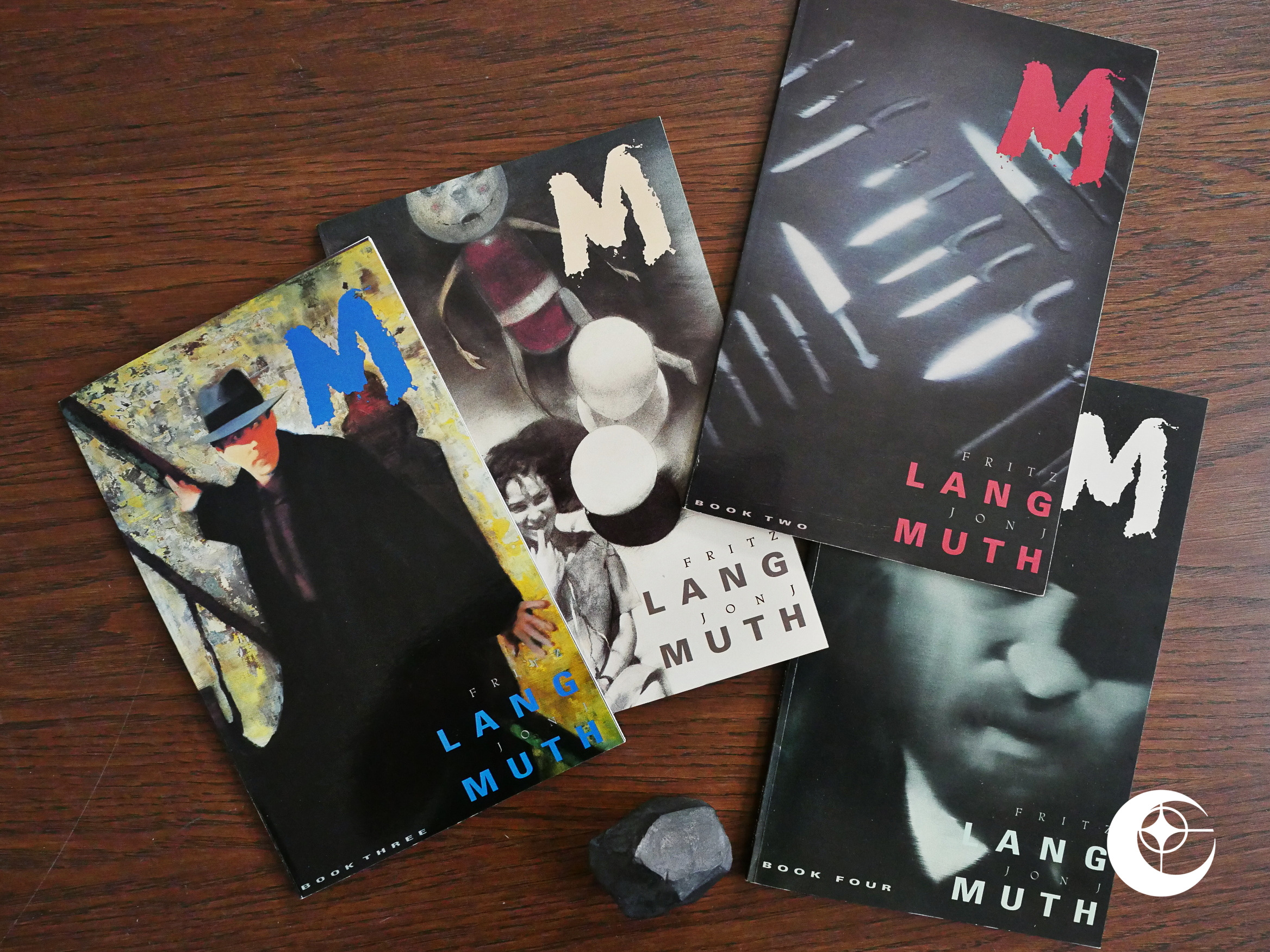 ...which was collected into a trade collection in 2008. Inspektor Lohmann, with Wernicke in the role, would reappear in Lang's The Testament of Dr Mabuse, as well as the 1960s Mabuse series, played by Gert Frobe, in return of Dr Mabuse and the remake of Testament of Dr Mabuse. M was adapted into a 6-part tv mini-series, for tv in Austria and Germany, in 2019. Next, a little something lighter as we look at two Italian caper comedies, featuring the Seven Golden Men and one smoking hot woman! |
|
|
|
Post by Calidore on Apr 14, 2020 17:22:04 GMT -5
Some fun bits of Peter Lorre trivia:
* While acting for Fritz Lang as the depraved child killer, he was simultaneously doing comedy on stage during the day.
* In Spike Jones' parody recording of "My Old Flame", Paul Frees did a raving Peter Lorre imitation. Later, when Lorre himself appeared on Jones' radio show and they did the song, Frees had to teach Lorre to do Frees' version of his own voice.
* Charles Addams used Peter Lorre as the inspiration for Gomez' look.
|
|
|
|
Post by codystarbuck on Apr 14, 2020 19:12:38 GMT -5
Some fun bits of Peter Lorre trivia: * While acting for Fritz Lang as the depraved child killer, he was simultaneously doing comedy on stage during the day. * In Spike Jones' parody recording of "My Old Flame", Paul Frees did a raving Peter Lorre imitation. Later, when Lorre himself appeared on Jones' radio show and they did the song, Frees had to teach Lorre to do Frees' version of his own voice. * Charles Addams used Peter Lorre as the inspiration for Gomez' look. Peter Lorre was also the model for Dr Gulliver, in the Super Friends episode "Gulliver's Gigantic Goof." 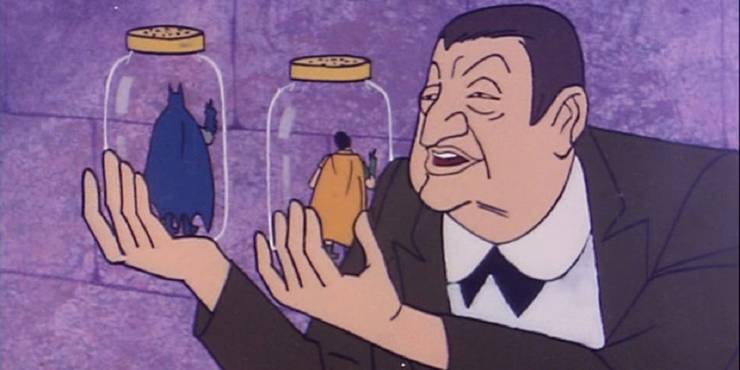 Peter Lorre was the first Bond villain on screen, in the Climax theater version of Casino Royale, where he played Le Chiffre....  |
|
|
|
Post by codystarbuck on Apr 15, 2020 16:30:53 GMT -5
Now for a bit of fun. I've always been a fan of the good caper comedies, as well as the more serious ones. Mission Impossible had me programmed for stories of a group working against the clock and impending discovery to pull off some daring operation. these are usually great for tension and drama and the comedies add all kinds of hilarious touches, when done right. I already talked about return of the Pink Panther, which opens with a great, dramatic jewel heist, which goes quite a while before delivering its first gag (roof door kicked into the face of a guard). Mission Impossible took its approach for the caper film Topkapi, with Peter Ustinov. Maximilian Schell is the gang leader, with Robert Moreley as the mechanical genius and Melina Mercouri as his partner and lover. Ustinov is a small time hustler they hire to drive a car into Turkey, with their equipment; but, after their strongman gets injured, as to take over his role. The highlight of the film is the intricate plot to break into the Topkapi palace and steal a jeweled dagger. It's a light-hearted film and fun, with an exotic locale and much time spent on Istanbul, including the oil wrestling. Director Jules Dassin also directed the classic heist drama, Rififi, which I will cover another time, with some other, more serious heist dramas. Along similar lines, but with far more charm and laughs is William Wyler's How to Steal a Million... Audrey Hepburn is a woman whose father (Hugh Griffith) is an art forger (a family tradition) whose fake statue is in a museum and about to be evaluated, for insurance purposes. Peter O'Toole is an insurance investigator who is on the trail of Griffith and breaks into his home, only to be surprised by Audrey, with an old flintlock pistol, which is still loaded. She hires O'Toole, believing him to be a burglar, to help her steal the statue from the museum, before it can be exposed as a fraud. O'Toole concocts a scheme, which we don't see until the pair actually execute it, with comic results. Along the way, O'Toole and Hepburn fall in love. Eli Wallach is a wealthy suitor of Hepburn and Charles Boyer an art dealer, while French comic Moustache plays a guard at the museum. The cast has terrific chemistry and plays it lightly, but never as slapstick. The laughs come from great lines of dialogue, character pieces, and a bit of physical stuff. Hepburn is dressed by her favorite designer, Givenchy, which leads to an in-joke where O'Toole presents her with a disguise to use, during the heist and says "Let's give Givenchy the night off." The film was shot in Paris and uses the locale for great effect. The plan itself, which I won't spoil, is quite brilliant and depends less on defeating alarms as it does on using them as a psychological ploy. Also in this line is the caper comedy Gambit, with Michael Caine and Shirley MacLaine.. Caine is Harry Dean, a cat burglar and con artist. MacLaine is a Eurasian dancer in a small Hong Kong club. Harry offers her $5,000 and a US passport to aid him in a caper, based on her resemblance to the late wife of millionaire Shahbandar (Herbert Lom). He plans to use her to get close to Shahbandar so that he can steal a jade bust, which also resembles the late wife and Nicole (MacLaine's character). We see the plan play out, with Nicole never uttering a word. They come to the attention of Shabandar and have dinner with him and see the bust. then, Harry breaks in and steals it and escapes, while Nicole slips out at the airport. Then, we find out it is all in Harry's head, as when he actually sits down with Nicole, he can't get her to shut up and nothing goes as planned. She agrees to help, but nothing goes smoothly. The hotel has changed, Shahbandar has changed security and he distrusts Harry. Nicole ends up charming Shahbandar and helping Harry improvise to pull off the heist. Again, it has a great cast that is charming and the comedy comes mostly out of character, though there are situational things, as Harry's plan is a wreck, from the start. These are great actors having fun with a great script. There are other great caper comedies, including another with Michael Caine that is a classic, which I will cover later. For now, though, I want to focus on two Italian films, with the same cast: The seven Golden Men and its sequel, Seven Golden men Strike Again.  The pair of films are from director Marco Vicario, with an international cast of actors and characters. The film opens with a beautiful woman who enters a Swiss Bank and plants a transmitter in a safe deposit box. Meanwhile, a group of utility workers set up shop on the street. They then tunnel under the bank and to the gold vault, guided by the transmitetr. They have an elaborate set up of conveyor belts and scoops that haul out the gold from under the bank's noses, guided remotely by the genius who planned everything, who is set up in a hotel. The film stars Italian sex bomb Rossan Podesta as Giorgia, the woman who enters the bank, and Philipe Leroy as Albert, the genius. Podesta gets to lounge about in sexy costumes, especially this little lace number..... 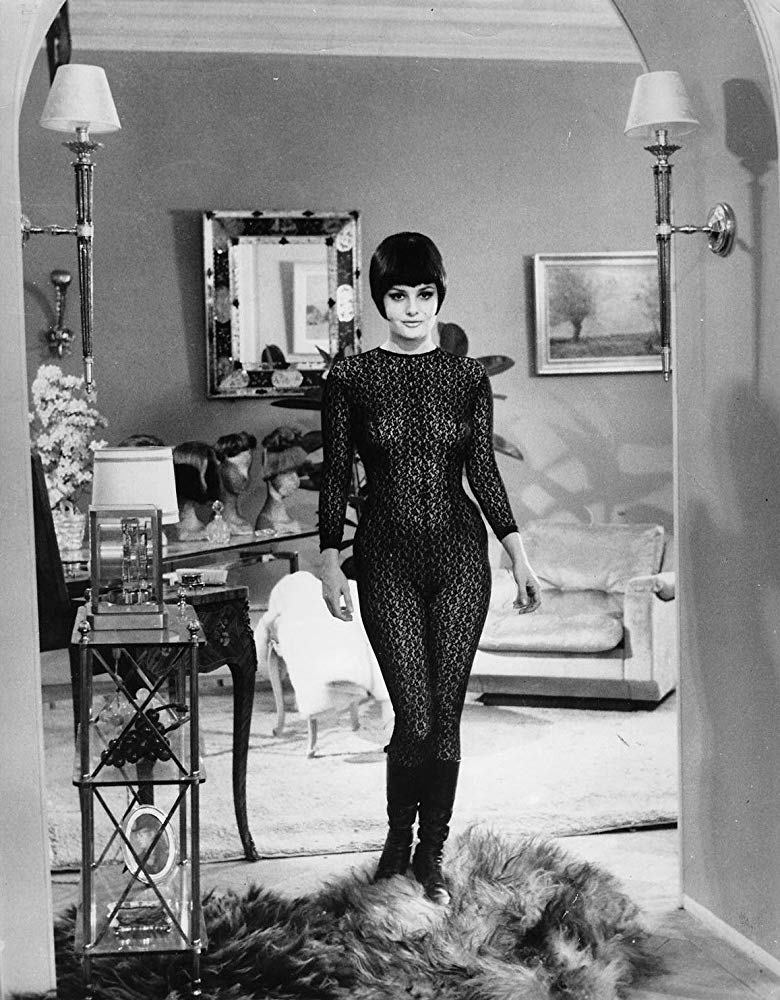 She distracts the people at the bank and at the hotel, including the police, once they know a crime has occurred. Philipe is a brilliant inventor and planner, but not to be trusted as he double-crosses his men, which leads to the second half of the film, as they chase after the gold. There are all kinds of mishaps along the way, including a crash of the truck hauling the gold, the various schemes and counter-schemes and plenty of character moments. the criminal gang are all from various countries, with no national stereotype left untouched (though mostly played by Italian actors). Podesta specialized in romantic films and had her greatest international exposure in Robert Wise's Helen of Troy, unless you count a partial nude spread in Playboy. She was married to Vicario, though they would divorce. In later years, she was living with mountain climber/explorer Walter Bonatti, but was not allowed to be by his side when he died, alone, in a private clinic, since she was not his legal wife. Philipe Leroy was a noted French actor, who had served in the French Foreign Legion paratroops, both in Indochina and Algeria. he started acting in 1960 and worked with many noted directors, including Godard, Deray, Dario Argento, and Luc Besson. he appeared in such films as 55 Days in Peking, The Night Porter, and La Femme Nikita. The film spawned a sequel, where the professor and his group are arrested, after a botched robbery, and blackmailed into becoming agents for the CIA, to overthrow a Caribbean dictator (obviously meant to be Castro, though not named as such). Giorgia gets close to the man, while the rest set up an elaborate scheme to drug and abduct him. The dictator is subjected to brainwashing, while the Seven Golden Men steal a gold shipment from the USSR and end up fighting over it, culminating in a war between stacks of Gold, on a small island. Both of these are silly, entertaining fun. What they lack in Hollywood production values they make up for in charm, playful fun, and a jazzy soundtrack. The second film includes all kinds of gadgets that would make Bond jealous, including a mini-hovercraft. The second film is rather like a comic Mission Impossible scheme, as much as a comedy caper. Now, about that Michael Caine film. Caine joined director Peter Collinson and co-stars Noel Coward, Benny Hill, Raf Vallone, John Le Mesurier and George Innes in one of the greatest caper comedies ever.... Caine is Charlie Croker, a medium level crook who is being released from prison. Noel Coward is Mr Bridger, the big crime boss who runs a criminal empire from inside the prison. He's a patriot, who thinks little of Croker. Charlie is passed a film made by an Italian friend, who was killed by the mafia. the target is a gold shipment, in Turin. Croker presents the idea to Mr Bridger, by breaking into the prison and passing along the plans, selling it as a way to help England's balance of payments. Bridger approves and the team is assembled, including Benny Hill as a kinky professor, who is a computer expert and has a thing for large women. He will reprogram the traffic computers that control the signals in Turin, to create a traffic jam that will allow them to hit the gold convoy and make their way out of the city, while police deal with the mess. The plan involves using Minis to move in an out of traffic and over an alternate route that includes stairs, plazas, tunnels, racetracks, rooftops and onto a mother vehicle. The film is a hoot, filled with great dialogue that has become iconic, with amazing vehicle stunts by Remy Julienne's driving team. Ironically, the iconic Minis almost didn't appear in the film, as BMC didn't seem to grasp the free publicity they were getting. They only provided a token fleet, with the rest bought at market price, while Fiat, who provided the Italian vehicles and whose proving track was used for scenes, offered them the use of all the vehicles they needed, plus cash money to feature their cars. The film is filled with great character performances and the criminal gang includes Stanley Caine, Michael's younger brother, who appeared in several films. Music was done by Quincy Jones, with an opening song performed by romantic singer Matt Monro (who sang From Russia With Love) and a song played over the heist escape, called "Get a Bloomin' Move on" (aka The Self Preservation Society), which is sung by the cast, and is made up of rhyming slang. The film is wonderfully British, funny, exciting, and filled with great actors doing what they love ad amazing stunt performers. Both The Italian Job and Gambit were remade for later audiences. The Italian Job was remade in 2003, with Mark Wahlberg, Ed Norton, Jason Statham and Charlize Theron. It's a fine caper; but nowhere near the fun of the original. The cast helps it quite a bit. Gambit was remade in 2012, with a Coen Brothers script, starring Colin Firth, Cameron Diaz, Stanley Tucci and Alan Rickman, which, despite the cast and directors, never got a theatrical release in the US. The film tweaks the plot to be a revenge crime against firth's boss (Rickman) with Diaz playing a wild cowgirl. The film is a model of everything wrong in Hollywood, as it bounced around studios and directors, with cast members coming and going, until it was slapped together with Asian money. The film tanked in the UK and had a world gross of just $14 million, which sunk any chances of playing in the US. Reviews were bad, to say the least. Next time, some more dramatic caper films, including a couple of French crime classics and a couple of international ones, as well as a lesser Robert Redford effort, based on a Donald Westlake novel. |
|
|
|
Post by codystarbuck on Apr 16, 2020 20:50:24 GMT -5
As noted last time, heist films were usually either caper comedies or taught dramas. We looked at the comedies, now some of the more dramatic.
When you talk heist films, one of the first that comes to mind is also one of the greatest: Rififi.
The film is directed by Jules Dassin, an American who was blacklisted after being named a Communist, by Edward Dmytryk. He had several films in Europe quashed by interference or pressure from the US government. This film was originally intended for Jean-Pierre Melville, but he stepped aside for Dassin.
The film tells of a criminal, fresh out of jail, who is down on his luck. A friend approaches him about a smash and grab robbery of a jewelers, but passes. he tries to start up again with his girlfriend, who is with a mobster who owns a gambling club. The woman is used to the high life now and is turned off by the criminal Tony. He beats the woman, then tells his friend he is in, but they should target the safe, not just jewels in the window. They assemble a group and break into the store and the safe and get away with it; but, one of the gang pockets a diamond ring to give to a lover, which alerts the casino hood. That leads to murder, torture and betrayal, plus the rescue of a kidnapped boy, to a tragic, yet inevitable end.
The film is a noir crime masterpiece. The characters are as flawed as you can get. the hero abuses a woman for wanting better than him, a failed crook. Friends betray, enemies kill. The young boy who ends up kidnapped is one of the few positive eleemnts.
The centerpiece of the film isa 30+ minute scene of the break-in, done without dialogue, music or much sound beyond actual noise created by their actions. It is mesmerising as the chip their way through the floor of a room above the store and into the store, then break into the safe and steal everything. Dassin based the heist on an actual break in, right down to using an umbrella to catch falling debris as they punch through the floor/ceiling.
The film is based on a novel, which feature the rival gang as Arabs and Rififi's as Europeans and gets rather racist. Dassin chucked that out and gives the casino owner a Germanic name. He expands the heist from the 10 pages of the book to a quarter of the film. He also used less known or fading actors. Jean Servais, who plays the lead, Tony, was an alcoholic whose best days were well behind him. he brings a world weariness to teh role that infuses the character. Dassin, himself, plays the Italian safecracker, after an Italian actor pulled out.
Rifif would be influential across the world, informing crime films everywhere, especially the work of people like Jean-Pierre Melville, who directed Alain Delon in Le Samourai (which then inspired John Woo's The Killer) and Le Circle Rouge, another great heist drama.
The plot is similar to Rififi and includes a similar heist, shot much in the same way, as a deliberate homage. The main difference is Andre Bourvil as Inspector Mattei, the police man hunting for another criminal, who is aided by Delon's character. Mattei's hunt for the second escaped man (Vogel) brings him on a collision course with the gang.
Melville also directed the masterpiece Bob le Flambeur (Bob the Gambler), about a criminal who plans the heist of a casino...
Bob is a gambler who served time for robbery, but has been straight for 20 years. A streak of bad luck puts him in trouble. he helps a young woman, Anne, avoid the attentions of a pimp, Marc, and lets her stay at his flat. He encourages a young friend, Paolo, to take up with her. Marc beats his wife, is arrested, and blackmailed into becoming an informant for Inspector Ledru. A friend of Bob's, an ex-con who works as a croupier, tells Bob about the amount of money in the casino at the end of the night. Bob concocts a plan to rob the casino, gets financial backing and recruits a gang. meanwhile, Paolo lets it slip to Anne, who tips off Marc, who plans to inform Ledru. Paolo kills Marc before he can inform; but, the croupier's wife alerts the police. Bob is set to be on the inside, when the gang hits the casino. To pass the time, he begins gambling and soon is on a hot streak that wins him millions. he orders it to be cashed out and is not present when the gang runs into the police, in a big shhotout. He leaves with the police and the money is put in the trunk, with allusions that he might get off and enjoy the money.
The film is a tremendous character piece, with the intricate casino heist uniting characters. the plot would go on to inform both versions of Ocean's 11, as well as several other films, and such directors as Guy Ritchie and Quentin Tarantino.
Our last two films both feature Edward G Robinson. The first is Seven Thieves...
The film features Edward G Robinson, Rod Steiger, Eli Wallach, Joan Collins, Alexander Scourby, Michael Dante and Berry Kroeger. Robinson is a discredited professor, in Monte Carlo, who hatches one last, bug scheme to steal 4 million Francs from the casino vault. he recruits Steiger, an old friend to run the gang. Walalch is a beatnik and Collins his girl. She is to lure the inside man into getting them in, while assistuing inside the casino, during the heist. they assemble a safecracker and muascleman, then attend a party in the casino. Steiger and Dante go out a window, into the manager's office and take an elevator to the vault, where they cut their way in and steal the money. Wallach fakes a heart attack and is brought to the manager's office. he is pretending to be wheelchair-bound, which the chair is hollowed and will transport the money. The money is secreted inside, while the manager calls an ambulance, driven by Kroeger. They get the money out, but discover the bills are new and sequential, meaning they are on file with the central bank and easily traced. They plot to get the money back to the casino.
This one is a mixture of light moments and drama; but, mostly drama, with a terrific cast of some of the best character actors ever. Collins is pretty good in this, too, marking a more seroius period, before she was chewing scenery in Dynasty and trashy films like The Bitch. the film won an Oscar for costuming.
Robinson would appear in the heist film Grand Slam, in 1967...
Edward G Robisnon is a teacher, in Rio, who is tired and retires. he returns to the US and plans the theft of millions in jewels, during Carnival. he assembles a team, including Klaus Kinski, George Rigaud, Riccardo Cicciolla, and Robert Hoffman to pull off the heist. Rigaud is the safecracker, Cucciolla the electronics expert, Kinski an ex-soldier and killer, and Hoffman is there to seduce Mary Ann, played by Janet Lee, who works for the diamond merchant and has the key they need. She discovers the theft of her key and alerts authorities, as the gang is pulling off the heist. There is a massive tist or two at the end, which I will not give away. This was an Italian film and swings between lighter, vcaper stuff, and very serious double-crosses, murder and betrayal.
Lastly, one of the better films adapted from Donald Westlake's Dortmunder series, about a hapless criminal. This one is Hot Rock, with Robert Redford...
The film is directed by Peter Yates and stars Robert Redford, George Segal, Ron Leibman, Paul Sand, Moses Gunn, Zero Mostel, and has a very young Christopher Guest as a policeman. redford is John Dortmunder, fresh out of prison, whose brother-in-law (Segal) gets him mixed up in a scheme to steal a diamond from a museum, stolen during a colonial period and wanted return by Gunn, representing an African state. Dortmunder and his team steal the diamond, but things keep going wrong and they have to steal it back, again and again. Sand swallows the diamond when he is caught by the police, and is broken out of prison by Redford and the gang. he reveals he hid the diamond at the police station and they have to pull a heist there, faking a riot and radical bombing. The diamond isn't there and they learn Mostel took it and has it in a safe deposit box. They have to get into the bank vault to steal it back, while Mostel makes his own deal to turn it over to Gunn and cut out the gang.
The film isn't perfect; but, it features a great cast of character actors who elevate the material. It's never exactly hilarious; but, there are plenty of fun moments and the characters are great.
Dortmunder would also be adapted in Bank Shot, with George C Scott (decent, if not great), Jimmy the Kid, with Gary Coleman and Paul LeMat, Why Me?, with Christopher Lambert, and What's The Worst That Could Happen?, with Martin Lawrence. Each film, except Jimmy the Kid, renamed the Dortmunder character. That film was also done in Italy and Germany, in separate productions. The Hot Rock was originally intended to be a Parker novel, by Westlake (as Richard Stark); but, he felt the repeated loss of the jewel made it too comedic for the more hard-nosed Parker and came up with Dortmunder, who appeared in 14 novels.
So, there we have some of the more dramatic caper films. Next, something very lighthearted and closer to the world of superheroes, as a pair of crooks and an FBI man become the Three Fantastic Supermen.
|
|
|
|
Post by codystarbuck on Apr 17, 2020 20:05:19 GMT -5
Okay, time for a film that is more fun than a barrel of monkeys in superhero costumes, and probably more agile! The success of the 1966 debut of the Batman tv series set off a worldwide phenomena. Suddenly, everyone was doing superhero stuff: on television, at the movies, and even on stage. Italy, which always took its cues from Hollywood, followed suit. It first did it with a film that mixed costume superheroes and lucha libre, with Superargo contro Diabolikus (which I will cover later). However, if one hero is good, why not 3? So, enter Tony Kendall (Luciano Stella), Brad Harris (Brad Harris) and Mick Jordan (Aldo Canti) as The 3 Fantastic Superman, with director Frank Kramer (Gianfranco Paolini). The film starts out with 2 Supermen, Tony and Nick, who are actually a pair of crooks with supersuits that augment their ability (well, except to accessorize) and they break into an embasyy to steal abunch of cash and jewels; but, run into a whole lot of guards and cops, which they handle by jumping around, punching them, and hitting them with a metal ball on a slinky! Turns out, it was all arranged by FBI agent Brad, to capture them. It fails and they escape. Brad eventually catches up to them and gets their help in taking down a supervillain, Golem, aka Walter Gottlieb, a millionaire who has a duplicating machine that can copy anything or anyone. His hideout is underneath a school, where the kids are prisoners and tortured and beaten. Brad gets a supersuit and joins the others in saving the kids and punching the bad guys. Did I mention how much fun this is? Tony Kendall was the international name for former model-turned actor Luciano Stella. he's a handsome, square-jawed guy that gets the ladies to swoon swig cocktails, dance to some jazzy 60s music, and stay the night. He had a long career in European films, including the spy series Komissar X, alongside Brad Harris. Harris was a bodybuilder, stuntman and actor who started out doing minor roles in the US (including Li'l Abner and Oceans 11) and then sword & sandal stuff in Italy, before moving on to more modern action genres. If they had done Captain America in the 60s, this was the guy to play him....  (Harris is the beefy dude on the right) 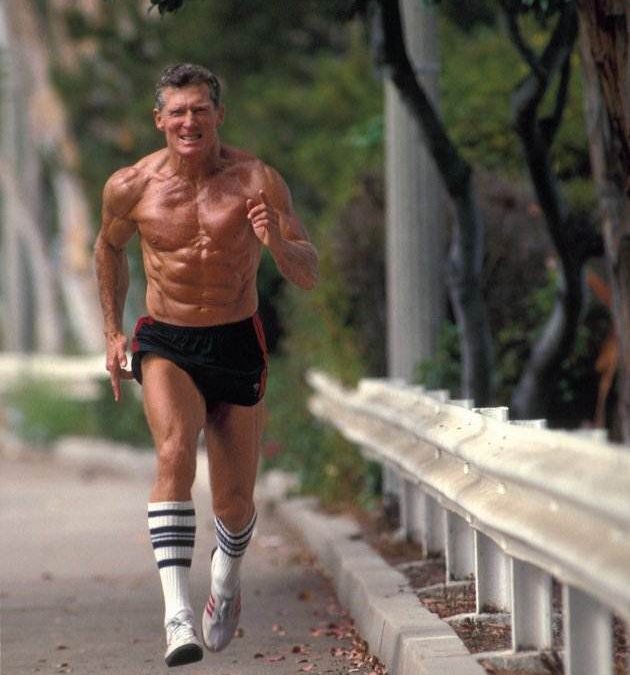 (This is what he looked like, at 80!!!!!!) 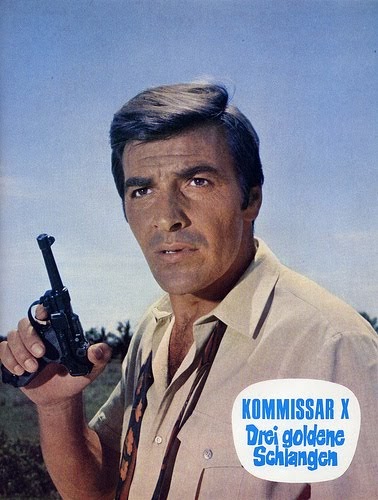 (Tony Kendall, in one of the Kommissar X spy films) Nick Jordan, aka Aldo Conti, was an acrobat and minor actor, who had a past as a real thief and ended up gunned down, after his film career was over. Because the actors could do a lot of their own stunts (all, in the case of Harris and Conti, Kendall did quite a bit of his); you don't get the fakes where the stunt man falls behind something and the actor emerges, and you can get tighter on the fights. There is a scientist who created the supersuits, who comes up with other gadgets and the villain, Gottlieb, has some henchwomen, including the sadistic Diana.... 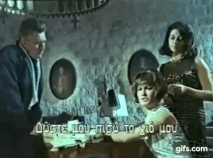 She's a nasty piece of work and isn't turned babyface, by the end. She gets hers when she is tossed onto an electrified floor and you don't shed a tear for her. The film is wild as all get out and the plot is rather lost in scenes of the three heroes punching people and jumping around on hidden trampolines. At one point, Conti dives out a window, hits a trampoline and lands on a moving truck! The film starts out with gusto, then kind of starts sucking air in the middle, before getting a second wind for the finish. The actors have great chemistry and Harris and Kendall would do the Kommissar X series together, plus a few other films. They didn't return for any of the sequels in this series, and there were a few. For the next film, the 3 Longunderwear Amigos head to Japan, for The 3 Supermen a Tokio. The plot is similar, that a government agent forces to two crooks to help with a mission, to find a recording that could cause a political scandal... Okay, so it isn't Visconte or Fellini; but, you can do a lot worse than one of these films. They were made to be light fun for families, with enough action for the kids and enough goofy stuff to get a chuckle out of the adults. In the third act, the villain zaps them with a ray that reduces them to the size of children! George Martin (Francisco Celeiro) and Sal Borges take over as the crooks, and Will Colombini is the government agent. After this, the trio joined Toto in Africa, with The 3 Supermen in the Jungle... Martin and Borges return and Brad Harris is back, though with a different name (still Brad, though). He's supposed to be the same guy, though, as his wedding is interrupted (which means no honeymoon!) and he has to take over a case to stop the Soviets from getting a uranium mine in Africa. To do this, he needs the other two nitwits and has to take a rocket (yep, just like the Fantastic Four) to the Middle East and free the other two (who tried to steal the sheik's gold) from prison (where they have been allowed to keep their union suits) and take a burrowing machine to Africa). After the bless the rains, they deal with all the jungle stereotypes and run into some white amazon hotties... 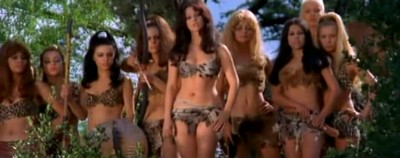 It doesn't take much for bikini babe jungle chicks to seduce the morons and they are enjoying themselves, until they learn that these Amazons are more like Black Widows, and are going to sacrifice them in a marital altar. I know divorce costs are high; but, that's a bit on the extreme side! So, off they go to fight the Soviets. This brings back a lot of the fun slapstick and acrobatic combat from the first one. Jump ahead, and the boys are headed to Bangkok and Hong Kong, where Italian superhero films meet Shaw Brothers kung fu. Only Sal Borgese returned, with newcomers Robert Malcolm, as the government agent, and Antonio Cantafora as the other criminal. Malcolm is sent to Thailand to look into the disappearance of 6 agents. He sits in a bar and gets a note telling him to head to Hong Kong, though after a bit of muy thai. He heads to Hong Kong, gets into a fight with some drug lord's goons, gets helped by local cops, who are kung fu masters and meets his old buddies. They work together to beat the drug lord and steal cash from the American embassy. Along the way, they learn kung fu from a couple of Shaw Bros. regulars. Here, kung fu meets MeeToo... The suits don't come out until the third act and our Chinese friends get them, too. The female, played by Shih Szu, is the only one who really pulls off the look...  Jackie Chan has a credit as a fight arranger and there is some fine kung fu, with a lot of silliness involving the ambassador, who should have been played by Charles nelson Riley, if they wanted someone that gay. There would be one more of these, 3 Supermen in the West... George Martin is back (must owe somebody) and Frank Brana is the third guy. Hijinks with a time machine dump them in the old west, where they appear to both poke fun at and steal from terence Hill's comedy spaghetti western Trinity series, as there are a lot of scenes that look like those films (the slapping with the gunman, the burly sheriff, who invokes Bud Spencer). By this point (before, really) these were strictly for kids. There were a couple of more, done in Turkey; but, those are really just name only. Realistically, the one to see is the original, The Three Fantastic Supermen. It has the best cast, plot and action, and is the most coherent. The others get progressively worse, though they had some moments, depending on your tolerance level for juvenile slapstick. Even the 3 Stooges seem sophisticated, by comparison. Next, we take a step back to look at an Italian superhero wrestler, who looks more like the Phantom than El Santo, who essayed 3 films (one in a revised format), as we look at Superargo. Also, we will take a peak at Argoman (the revised Superargo) and Goldface, the Fantastic Superman. Time permitting, we will also look at Avenger X and Flashman (not the George MacDonald Fraser c anti-hero, nor the Japanese Super Sentai series). Come on back for more Paisano Superheroes. |
|
|
|
Post by codystarbuck on Apr 19, 2020 21:02:57 GMT -5
I have loved comic books, since I started to read. I enjoyed professional wrestling from the time I first watched International Championship Wrestling, with Mach Man Randy Savage, leaping Lanny Poffo, and One Man Gang Ronnie Garvin. prior to that, our local tv had flirted with broadcasts of the WWA promotion, from Indianapolis, run by Dick the Bruiser and Wilbur Snyder. however, we only had the show for very brief periods, when they promoted a few cards in Springfield. ICW stuck around and had regular matches in Springfield and Decatur (and a few other spots in Illinois) and had actual storylines, which the WWA really didn't. Savage and Lanny moved around the ring like superheroes and Garvin made it look real. Savage sounded like a supervillain. However, the wrestler that really hooked me on wrestling as comic books-come-to life was Tiger Mask. The Tiger Mask manag series began in 1968, created by Ikki Kajiwara (creator of the boxing series Ashita no Joe) and drawn by Naoki Tsuji. It told the story of a masked wrestler, who had lived in an orphanage, under the name Naot Date. He ran away and eventually found his way to the Tiger's Den Organization, who trained villainous wrestlers, in exchange for half their earnings. Tiger Mask encounters a young orphan who wants to be a villain, like him and he is shocked. he follows the boy to the same orphanage he ran away from and decides that he doesn't want another boy to follow in his footsteps. He "turns babyface" , becoming a hero and gives his money to the orphanage, angering the Tiger's Den, who send their wrestlers to punish him in and out of the ring. The series featured actual wrestling stars from Japan, including Giant Baba and Antonio Inoki, as well as foreign stars, like Freddie Blassie, the destroyer and Jack Brisco. The manga spawned a cartoon series (and sequels) and then a live wrestler, in the early 80s, portrayed ny Satoru Sayama, a smaller "junior heavyweight" wrestler, who trained in Japan, Mexico and the UK, learning their different styles. He mixed the high flying lucha libre style of mexico, with the mat-based style of the UK, and the martial arts and submission mix of Japan. He had legendary matches with the Dynamite Kid, Marc "Rollerball" Rocco (as his masked rival, Black Tiger) and Villano III (a top Mexican star), He wrestled on tours for the WWF, under Vince Sr, including a bout in Madison Square Garden, against Dynamite Kid that woke up an indifferent MSG crowd, who had never seen anything like it. They barely responded to the match until the guy start pulling out amazing moves and exchanges and then start cheering theri heads off. I saw Tiger Mask in 1982, on one of those MSG broadcasts. from then on, I was hooked on wrestling, even more than before. A few years later, on Commander USA's Groovie Movies, I would see my first Lucha movies, with El Santo and the Wrestling Women (who starred in two films) . those were more like superhero films than most from Hollywood. It turned out, that mexico and Japan weren't alone in doing this kind of thing. With the Batman craze, in 1966-67, and the James Bond Craze, Italy jumped on the bandwagon, creating the wrestling superhero/secrtet agent Superargo! Superargo is a masked wrestler who accidentally kills his opponent, El Tigre (who wears leopard-skin trunks, but tigre, in Spanish, is used for various jungle cats, not just Asian tigers) and gets depressed. His helmet-haired girlfriend (it looks like a wig, but 60s hairdos, with tons of hairspray, often do) gets him a job with the Secret Service and he is first tested to catalogue his amazing abilities. he is stabbed and feels no pain nor bleeds. he survives extremes in temperature and can hold his breath for prolonged periods. He is nigh invulnerable, just like The Tick. He is sent after Diabolicus, a pirate who is stealing uranium shipments to create a superweapon. He attacks ships with speedboats and goons who get their clothes from the HYDRA catalog (he has an octopus emblem on his suit). Superargo comes after hima nd machine guns the goons in high tech hallways and industrial areas, while withstanding torture (the girl gets tortured too, as is tradition). It is notable how much Superargo resembles the Simon & Kirby Manhunter... 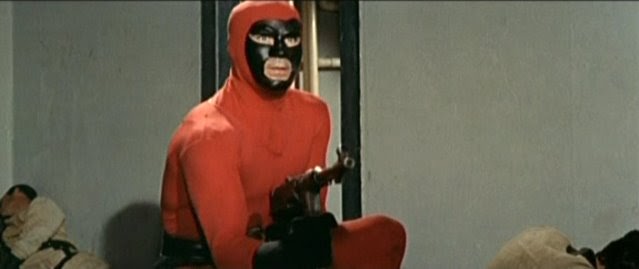 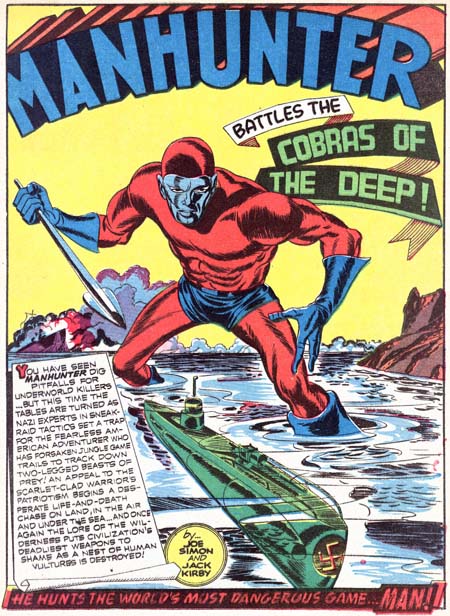 The film basically takes the lucha hero, as in the El Santo movies (which were very popular in Spain, where this film was partially shot and co-financed) and the Eurospy template, as seen in such things as Mission Bloody Mary and the Kommissar X series. The hero also resembles The Phantom, to a certain extent, who was massively popular in Europe. The film starts out a bit slow; but, Diabolicus' pirates liven things up and it gets better once Superargo is chasing and killing the bad guys. It can be seen as either a straight action-adventure film or a lucha/spy parody, though it is totally deadpan, which is why you can view it either way. It never winks at the camera, no matter how ludicrous it gets. The film did well enough for a sequel; though, Italian film sequels got even lower budgets than Hollywood ones did. That sequel was Supeargo vs the Faceless Giants... This time, Superargo faces a madman (what else) who controls robot zombies, who look like an even lower budget version of the Cybermen, from Doctor Who. They don't do much, until you get in the way. Superargo also got a face lift, as his mask is now just and eyemask, instead of a full face mask (with cut-outs). This makes it look more like Batman (tv) in shape, and makes him seem more like The Phantom. Rifftrax did a number on this one... He also gets a new sidekick, a Sikh mystic, called Kamir, a new girlfriend, and an E-type Jaguar (just like Eva Kant, in Diabolik). That was it for Superargo; but, he got a cousin, in the slightly more deliberate parody, Argoman, The Fantastic Superman.... The film is directed by Terrance Hathaway, aka Sergio Grieco, who also directed the Dick Malloy Eurospy films (Mission Bloody Mary, From the Orient with Fury, Special Mission Lady Chaplin) and stars Roger Browne (an American who worked in Italian films, with bit parts in a few Hollywood costume epics) and Dominique Boschero. Argoman is Sir Reginald Hoover, a super-secret agent who can hypnotize people and beat the bejeezus out of them, without landing a solid shot. He has an Indian manservant (Chandra) and loses his powers for 6 hours after nookie, which seems to happen often. He meets up with a woman named Regina (secretly a villain, called Jenabell) , who steals the English crown, then demands a massive gem as payment. This is pure camp and a lot of fun, though that is one ugly costume. Superargo/Argoman would go on to inspire Superseven, a spoof character in a series of films on Youtube, from the same people who do the Sandra West Diaries (spy spoofs)... One of the early knock-offs was Goldface, the Fantastic Superman (notice a trend here?). This more of a direct lucha movie and was shot (extremely cheaply) in Venezuela, using actual luchadors. It deals with terrorist attacks by The Cobra and his men (Cobraaaaaa!!!!!), but no GI Joe; just a guy in a really bad mask, especially by lucha standards.  Goldface has a helper, Kotar, who is a horrible African savage stereotype. Goldface is actually Dr Vilar, a scientist with a bunch of female assistants with low necklines. His boss is a millionaire whose daughter is targeted by Cobra. Goldface saves her and fights Cobra's goons. There is also Mister X/Avenger X; but, that is based on a fumetti, a knockoff of Diabolik 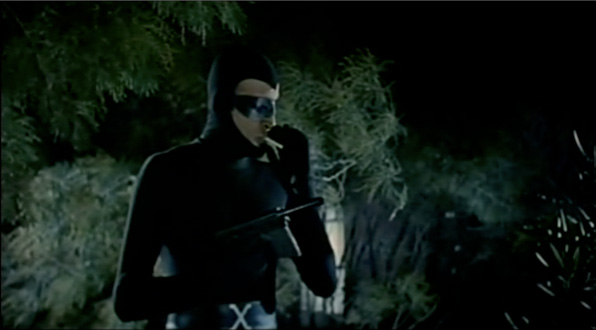 I suggest sticking with Diabolik (aka Danger Diabolik), Kriminal or Satanik. The last of this bunch is Flashman... More campy silliness. Since we are in that arena, next time, we will look at some of the various lucha movies out there, especially the lucha Justice League, Champions of Justice. |
|
|
|
Post by berkley on Apr 20, 2020 13:08:48 GMT -5
I'm hoping to watch Rififi and Bob le Flambeur sometime soon, as I've been getting into some stuff from the 50s. The 60s movies will have to wait for later but a lot of them look very attractive from these stills, looking forward to them!
|
|
|
|
Post by codystarbuck on Apr 20, 2020 19:29:13 GMT -5
From Italian lucha/superhero films to Mexican. Mexico has a long and rich tradition of professional wrestling, known as lucha libre. As with Europe, the love affair really began in the 1930s, when the premiere promotion, Empresa Mexicana de Lucha Libre was formed, by Salvador Lutteroth. Prior to that, pro wrestling shows in Mexico had been foreign shows, sometimes using local wrestlers. Lutteroth was working in Ciudad Juarez and viewed a show in nearby El Paso, with Greek wrestler Gus Pappas. He formed his new company in 1933 and became the top promotion in the country. he introduced his first masked wrestler in 1934, La Maravilla Enmascarada or The Masked Marvel, who was an American, under a leather mask. Masked wrestlers had appeared in the US, but rarely rose to main event status (and wrestling was governed by athletic commissions and promoters were loathe to present a masked gimmick on top, for fear of not appearing legit. The Marvel was a hit and more masked wrestlers were introduced. In 1942, Rodolfo Guzman Huerta debuted a new masked persona, known as El Santo and became a legend... 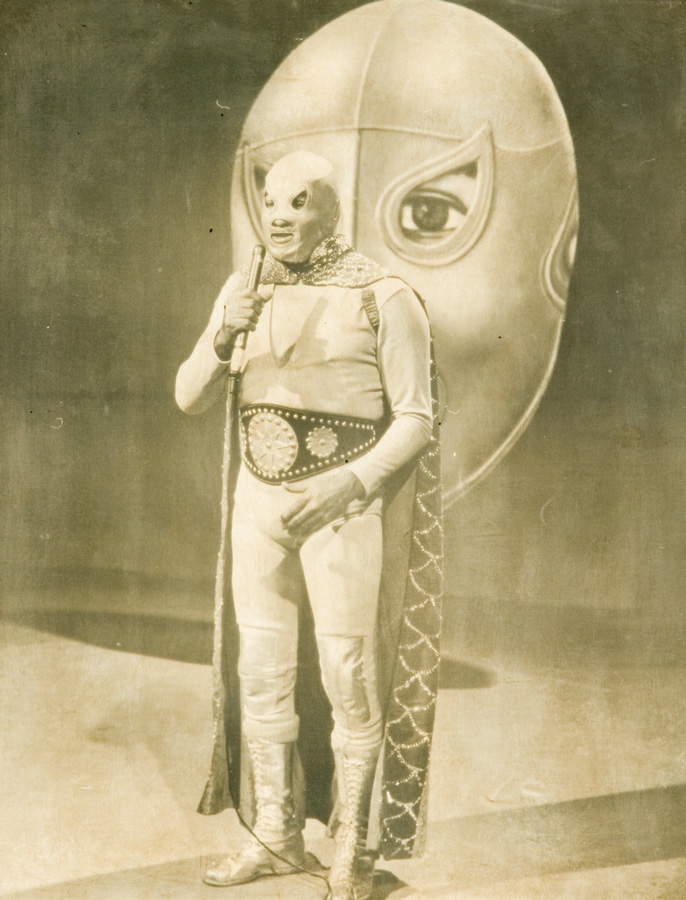 El Santo became a sensation in Mexico, as was his tag-team with Gory Guerrero (Salvador Guerrero Quesada), the patriarch of the Guerrero wrestling family that included sons Chavo (Salvador Jr), Mando, Hector and future WWE Champion Eddie; as well as grandson Chavo Jr (Salvador III) and granddaughter Shaul, and daughter-in-law Vickie. A movie was made, called The Man in the Silver Mask, without Santo, which was a big hit. Santo was enticed to appear in a film, provided he could continue his wrestling career. His first two films, The Evil Brain and The Infernal Men see his as a masked sidekick to the hero. the latter was filmed in Cuba and wrapped just before Castro came to power. With his third film, Santo vs The Zombies, he had become a film star.  This set the tone for most Santo films as he usually faced supernatural enemies or mad scientists who created monsters. The popularity of these films spawned a whole wave of lucha movies, starring both actual wrestlers and actr/wrestlers under a film character name. While his film career was going, Santo also appeared in comic books, by Jorge Cruz, which were second only to the superhero Kaliman (an Indian mystic hero). Santo starred in over 52 movies; but, i have only seen one of his, which I will discuss, in a moment. His most popular film was a team-up with fellow masked film stars and wrestlers Blue Demon and Mil Mascaras, in The Mummies of Guanajuato... Probably the best known Santo film, in the US, is Samson vs the Vampire Woman. American producer K Gordon Murray distributed a lot of mexican films to drive in and juvenile audiences and that included a few of the lucha films, including Santo vs the Vampire Women. For whatever reason, Murray retitled the hero as Samson, which is the name used in the English dubbed version. I first saw this on Commander USA's Groovie Movies, when it first appeared on the USA Network. It sets the basic tone for these movies, with a supernatural threat attacking innocents and the police unable to stop it. Santo, who first appears in a wrestling match, runs in to fight opff the rather wrestler-looking henchmen of the vampires, who are trying to nab a woman, to revive their queen. He fights them off and they are especially vulnerable to him because of his silver mask and presumed divine powers. (which are mostly punches, kicks, bodyslams, and wrestling holds). Santo turns up, in mask and cape, driving a convertible, then hops out and beats the stuffing out of the vampire goons. Even Batman didn't get to fight vampires with dropkicks! The film is a bit goofy, and it is a bit long, especially the two big wrestling matches, which while entertaining, are probably not favorites for people who aren't fans. SDtill, by the end, Santo gets to kick vampire butt. The film was chosen to show for Frank Coniff (aka TV's Frank) send off, on MST3K.... If you enjoy low budget, goofy horror, this is a ton of fun. If you prefer something a bit more palatable, then I recommend watching the MST3K version (available on Youtube). Santo was soon joined by rival wrestler Blue Demon (Alejandro Munoz Moreno) who was actually the better wrestler of the pair. he primarily wrestled as a rudo or villain (a "heel" in US pro wrestling) but portrayed a hero in his movies and was eventually turned into a technico, or hero. He had appeared as one of several wrestlers in a couple of films, before starriong in his own series of films, starting in 1964. santo had asked for a pay increase, so producers wanted another hero to hedge their bets. He appeared in 25 films, 9 with Santo, and 3 where he was the leader of a squad of heroes, which we will get to, in a moment.   Santo and Blue Demon would soon be joined by another wrestler-turned-film star, whose persona originated in comic books. With the Santo comics selling huge numbers other characters were created, especially to spin off into films. The bigegst was Mil Mascaras (1000 Masks), portrayed by Aaron Miguelito Rodriguez Arellano. He would soon star in his first film, titled Mil Mascaras, where he is immediately portrayed as a superhero... Notice Mil doesn't "sell" much? Mil Mascaras was probably the first lucha gimmick specifically created to be a film star, rather than just translate over to one. He had wrestled under other names, before starting as Mil Mascaras and was soon followed by his brothers, Dos Caras (Two faces) and Sicodelico (Psychedelic). All three were sensations in Mexico, particularly Mil and Dos. Mil would work extensively in the United States, for the WWWF (precursor to the WWF/WWE) and the Los Angeles promotion of Mike LeBell, where he held the Americas title. He was also the inaugural champion for the International Wrestling Alliance, the first attempt to create a national wrestling promotion, with ties to syndicated broadcasting and Eddie Einhorn, co-owner of the Chicago White Sox. That group quickly went under, but Mil continued to "defend" the IWA title for decades. He was also a big hit in Japan, wrestling for All Japan Pro Wrestling, where he would help inspire the character of Tiger Mask and future masked wrestlers and pave the way for many Mexican luchadors to work in Japan, including Eddie Guerrero. He was a big draw in the 70s; but, by the 80s, had drawn a reputation for not being cooperative with promoters, refusing to "put over" (lose) to local stars and pretty much performing the same basic match, with little variation. However, he was inducted into the WWE Hall of Fame by his nephew, Alberto Del Rio, aka Dos Caras Jr, son of Mil's brother, Dos Caras. Probably the best lucha film to come along for American viewers is the luch Justice League, known as Los Campiones Justiceros aka Champions of Justice... The film stars Blue Demon, Mil Mascaras, Tinieblas (who also had a comic book), Sombra Vengadora and Medico Asesino (a rudo, who starred in The Man in the Silver Mask, when Santo passed on it). Each masked man is the sponsor of a contestant in a beauty context, which is targeted by a mad scientist, who has an army of augmented masked Minis (the lucha term for midget wrestlers, who were actually portrayed in straight matches, and not just the comedy matches seen in the US). It is rather ironic that Mil Mascaras sells for midget wrestlers; but, wouldn't for Mick Foley, when he was a rising star who outweighed him by about 35 pounds and had 2-3 inches in height on him (and was far younger). Each of the guys has his own signature vehicle and a motorcycle and is ambushed individually, before they fight as a team and give their bathing suit mamacita a lift on their bikes. The team returned in Vuelven Los Campeones Justicieros (The Champions of Justice Return), with new additions Fantasma Blanco, Rayo de Jalisco, and Avispon Escarlata (plus Mil and Blue Demon). 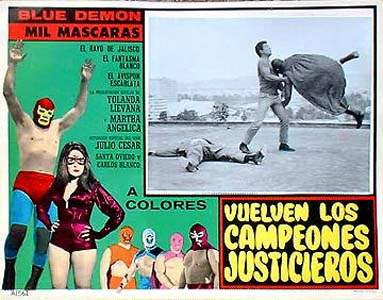 They had one more appearance in Triunfo de Los Campeones Justicieros (Triumph of the Champions of Justice), with new members Superzan, Fantasma Blanco and Elsa Cardenas, as Venus. Cardenas was an actress who plays a luchadora, in this one.  Santo, Blue Demon and Mil Mascaras teamed up again in Misterio en Las Bermudas (Mystery in Bermuda), where the trio protect the princess of a country, who is in Bermuda to negotiate a peace treaty. Bermuda was chosen because of the Bermuda Triangle fad that was going on in the 70s, when people were too baked to be skeptical of such wild tales of "unexplained" phenomena (The Bermuda Triangle covers a very large area, at random, which has a lot of ship disappearances; but, you could get similar results in other ocean areas and even the Great Lakes). The part where the princess is rescued and points two fingers at the terrorists eyes is kind of telling. Pro wrestlers were trained to go for the eyes if they got into a real street fight, to protect themselves and the business, after an NWA champion was beaten in a street fight, in the 1940s. Santo continued to wrestle and make appearances into the early 1980s. He finally retired in 1982, wrestling his last match alongside Gory Guerrero, who came out of retirement for the event (he promoted in Ciudad Juarez and El Paso). He was followed into the business by his son, Hijo del Santo, who also appeared in a few movies and teamed with Gory's son, Eddie, until Eddie turned heel on him and joined Art Barr as Los Gringos Locos, the most hated wrestlers in mexico, in the early 90s. They had a legendary mask vs hair match at the When Worlds Collide PPV, which made Eddie a name in US wrestling, leading top him wrestling for ECW, then WCW and the WWE. In 1984, Santo appeared on a tv show, Contrapunto and removed his mask... A week later, during a stage show, he collapsed and died of a heart attack. He was buried in his mask and his funeral was attended by thousands. He was the biggest sports or entertainment star in Mexico and his death was likened to that of Elvis, in the US. Blue Demon passed away in 2000 and was succeeded in the business by his adopted son, Blue Demon Jr, who became the first masked NWA World Heavyweight Champion (and also promoter of NWA Mexico, a rival group to the bigger leagues of CMLL, the former EMLL; and AAA, an offshoot of EMLL). In 2007 he appeared in Mil Mascaras vs the Aztec Mummy. Now, I mentioned that there were also lucha heroes created for the screen, who did not wrestle, as their main profession. The biggest of these was Neutron.  He was portrayed by Wolf Ruvinskis, who was born in Latvia, to Lithuanian Jews, who emigrated to Argentina, ahead of the Nazi invasion. He grew up poor and trained to become a luchador in Argentina and soon became a top wrestler in various South American and Mexican promotions. By 1950, injuries had forced him to retire. He had had a few small parts and soon had a bigger one in Bestia Magnifica, a horror movie, in 1953. That soon led to starring in a series of films as Neutron, a masked hero, starting in Neutron vs The Amazing Dr Caronte. There were 4 more: Neutron in the Black Mask, Neutron vs the Death robots, Neutron vs the Maniac and Neutron vs the Karate Killers. The first two films and Ruvinskis' previous lucha film, Ladron de Cadaveres, can be seen on Youtube. I've watched Neutron vs The Amazing Dr Carontes and it's pretty good, is a bit hampered by budget. A mad scientist causes havoc and Neutron aids the police in stopping him. Like Samson, Neutron got some joke treatment, from the Rifftrax crew... Neutron is seen battling the villains, rather than wrestling matches, so he is more of a true masked superhero than Santo, Blue Demon or Mil Mascaras. There is one more lucha movie franchise to discuss, before leaving: the Wrestling Women. The first film in the series is Las Luchadoras Contra El Medico Asesino, aka The Doctor of Doom, aka Wrestling Women vs The Doctor of Doom. The film stars Lorena Velazquez and Elizabeth Campbell as the wrestling tag-team Gloria Venus and the Golden Rubi. A mad doctor is kidnapping women to use in brain transplant experiments and Gloria's sister is one of his victims. the ladies work with a pair of lovestruck detectives to stop the mad doctor and his ape, Gomar. At one point, he creates a maniac female wrestler and sicks her on Gloria Venus. Velazquez was an actress, not a wrestler and is doubled in scenes by an actual luchadora, who is noticeably shorter and stockier. Velazquez does a few basic throws, but any time you see anything special, it is her stunt double (the average female wrestler tended not to be built or have the looks of a film starlet). Actual wrestler Chabela Romero portrays Vendetta, the mad doctor's wrestler/killer Vendetta. This is pretty darn good and I saw it on the same episode of Commander USA's Groovie Movies, as Samson vs the Vampire Women. Besides lucha libre, the two films had a connection, as Lorena Valazquez plays the vampire queen in the Santo/Samson film. The luchadoras would return in a sequel, Las Luchadoras Contra La Momia, aka Wrestling Women vs the Aztec Mummy. An Asian villain is kidnapping and killing archeologists, who stumble on an Aztec codex. The villain has some judo ladies to fight Gloria Venus and the Golden Rubi. Both of these films were released as a set by Something Weird Video, which specializes in low budget cult films and skin flicks, though it is now out of print. Wrestling Women vs the Aztec Mummy can be seen on Youtube and Doctor of Doom can be seen in Spanish (Las Luchadoras Contra El Medico Asesino), with an annoying watermark over the screen, through the entire film. No look at lucha movie would be complete without a soundtrack and nothing fits better than some great surf music. First up, short-lived surf band The Ghastly Ones (name taken from a low budget horror film) with their trubute to Los Campeones Justicieros.... Their album, A Haunting We Will Go-Go is a tribute to low budget horror, surf and lucha, with a little mini-story told between songs, as the band meets up with Dr Diablos, with Los Campeones de Justicio called in to help, at the end. The album was part of Rob Zombie's short-lived Zombie A Go-Go label, at Geffen, which had a few really great albums, including a Halloween-themed album, the Ghastly Ones and The Bomboras. Of course, the surf revival owed it's brief flame of awesomeness to Pulp Fiction and Dick Dale's Miserlou, which helped throw attention on bands, such as the very lucha-themed Los Straitjackets... You want some tunes to play while reading through Love & Rockets? Los Straightjackets! First read about these guys in Filmfax's companion magazine, Outre, which covered their first album and mentioned their appearance on Conan O' Brien's show (they have made several, including with Nick Lowe). Really awesome band (with some line-up changes over the years) which led me to Teisco Del Rey, El Vez, The Ghastly Ones, the Bomboras and man or Astro-Man. So, what's next? How about a butt-kickin' squad of female secret agents, out to stop a madman. No, it's not Charlie's Angels, but, it is where Aaron Spelling swiped the idea! |
|
|
|
Post by codystarbuck on Apr 21, 2020 18:37:31 GMT -5
In the 1960s, with the explosion of the spy genre, we got some interesting evolutions that would have a big effect on the women's movement. The Avengers gave us the intelligent, capable, and dangerous amateur female colleagues to John Steed, with Cathy Gale, Emma Peel and Tara King (and, later, Purdy). It also gave us the detective series Honey West, with Ann Francis, then several films in Europe and America, with female spies, assassins, or troubleshooters, such as Deadlier Than The Male, Fathom, and Modesty Blaise. The Civil Rights and Anti-War Movements of the 60s helped pave the way for the Women's movement, which led to films aimed at a female audience, though often with exploitive elements to appeal to men. Ou of this mixture came a low budget action film from Ted V Mikels. Mikels had worked on the fringes of Hollywood, producing documentaries and educational films, while also working with special effects people for western stunts. He then started producing low budget horror and exploitation films and The Doll Squad was one of many of his films. This one would be about a team of butt-kicking female secret agents, with coordinated action jump suits, who have to infiltrate an island and defeat a criminal madman. Michael Ansara (deeply slumming it, but, it wasn't always easy to get parts for actors of exotic looks, like the Syrian-born Ansara) is the villain, who steals a missile. A CIA man, in a pretty low rent office, summons top agent Sabrina Kincaid. he gives her her mission and sends her tor recruit her all-female team.  The team inclusdes martial arts and demolition experts, as well as an exotic dancer, played by Tura Satana (Faster Pussycat, Kill! Kill!). The ladies then change into bikinis, pilot a motorboat out to the villain's private island, get a few guards drunk (and slip them a mickey) and then atatck the goons.    Of course, they get captured and tortured...  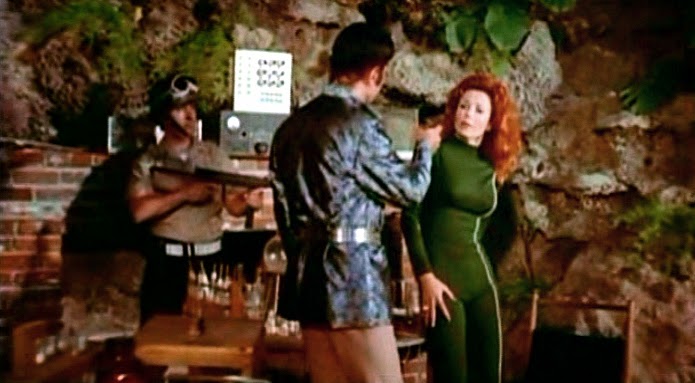.jpg) Sabrina escapes and frees the other, then they kick more butt and stop the villains plans. Now, that all sounds exciting and fun; and, it occasionally is, except on a reallllllyyyy cheap budget. The CIA HQ looks like a low rent real estate office... 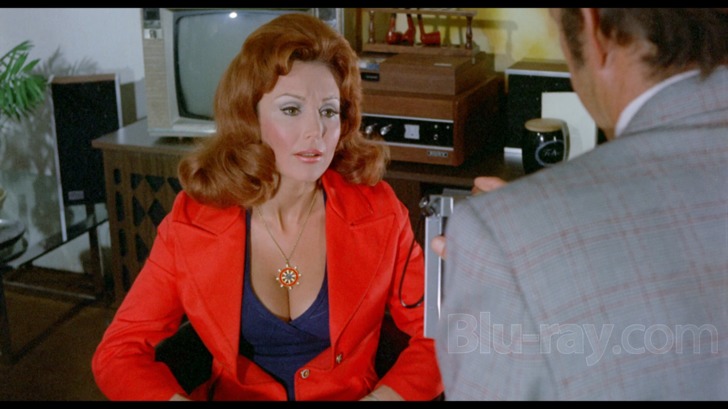 and the villain's HQ is a rather suburban looking house. However, the ladies have form-fitting Emma Peelers and white boots and get to run around shooting people, chopping and kicking goons, and blow stuff up. That covers a lot of sins, plus, the T&A factor. No acting awards are going to be won, but, Ansara is good enough to cover the villain side and there is enough humorous stuff to make up for some of the cheapness. The poster has you believing the film is way more epic than it really is....  Mikels other work can be seen on MST3K (Girl in Gold Boots, Agent for Harm). MST3K also included similar films, like The Wild World of the Batwoman and Angel's Revenge... Batwoman has nothing to do with the Batman comics; but is just gonzo weirdness. Angle's Revenge is a failed knockoff of Charlie's Angels. On a slightly more watchable scale is the 1980 Australian movie Touch and go, with Wendy Hughes... I caught this one on USA Network, back when they used to show a lot of movies from other countries (like this, the Callan film, Fraulein Doktor, and others). A group of suburban women are secretly carrying out a series of robberies to support a school for orphans. After a bit of miscalculation with their takings, they realize they need a big score and come across an island resort and casino that keeps a large amount of cash and is a bit lax in security. One of the members masquerades as a guest and gets shown around the facilities, including the vault and the casino. They then recruit some specialists to fill out the team and disguise their gender, in wet suits and rob the casino and make off with the money. They hide it in the roof of a van, to get past police checkpoints. However, one of their husbands mistakes the trash bags of cash as part of the garbage and it ends up at a trash dump. This is a caper film that is mildly amusing, sometimes clever (they record a male voice reading "lines" which they then use to make the casino workers think men are robbing the place) and at least entertaining enough for the duration. Next, we head into space for some space opera goodness and badness. See what passed for rivals to Star Wars, in 1978 and 79. |
|
|
|
Post by codystarbuck on Apr 22, 2020 11:00:14 GMT -5
Forget to mention, in the lucha movie survey. In 1988, Mil Mascaras and brother Dos Caras appeared in a movie La Verdadde la Lucha aka The Truth About Wrestling. iZn the film, Mil and Dos are masked wrestlers, as the Dragon Brothers; but, they split up and go on international tours, under their new names of Mil Mascaras and Dos Caras and face each other in the ring. What was unique about the film as it has a scene showing the brothers unmasked and it is really them....  Mil has the mustache. Dos' son, Dos Caras Jr had been a top amateur for Mexico, before turning pro and participated in MMA, in Japan, wearing a modified version of his mask, before giving it up. He came to the WWE as Alberto del Rio, though they eventually mentioned his relationship to his father and uncles. He was released from the company after slapping someone from the office who insulted him and bounced around the other promotions, with issues related to his girlfriend (another wrestler, can't remember who) and drugs. He has also done MMA with Combate Americana. Alberto discussing his uncle... Ironically, he says there that Mil will never unmask, yet he had already done so, some 30 years before, in that movie. |
|
|
|
Post by codystarbuck on Apr 22, 2020 17:10:33 GMT -5
So, I don't think I need to convince most comic fans that they would enjoy this film..... Man, I remember seeing that trailer, while we were there to see either Midway or The Pink Panther Strikes Again; that looked like the coolest thing; but, I was thinking of it in terms of a Ray Harryhausen film (The Golden Voyage of Sinbad was 3 years before); boy was I wrong. We all know it was a phenomena and the anticipation for the sequel was massive and The Empire Strikes Back met or exceeded most expectations. Then, we waited for the end and were either okay with it, somewhat let down or thought it was pretty good. That's all well tread ground. What is often forgotten is a wave of sci-fi/space opera films that followed. Now, Space Opera has been around since the late 1920s and early 30s, with things like the original Buck Rogers pulp story (Armageddon 2419 AD) and comic stripo, the Flash Gordon comic strip , and the pulp stories of Edmond Hamilton (Captain Future) and EE "Doc" Smith (Skylark and The Lensman Saga). Buck and Flash Gordon got movie serials. Republic gave us the Rocket Man, in King of the Rocket Men, which turned into the space opera Radar Men from the Moon and Zombies of the Stratosphere. Republic also had the Flash Gordon rip-off, Undersea Kingdom, with Ray "Crash" Corrigan. Space opera mostly gave way to Atomic Age sci-fi/horror, with mutated monsters and the like, r tales of alien invasions. The 1970s and George Lucas brought us back to the swashbuckling tales of the past. Following Star Wars, we first got some international quickies. First out of the gate was Japan and the Toei Company, who produced many effects-laden tv shows for Japan (including the Super Sentai series, that spawned the Power Rangers). They pretty much swiped the plot, wholesale... An evil conqueror attacks a peaceful planet, who sends off some space acorns to gather a group of heroes to save them. It's a mixutre of Kurosaw and Star Wars; or, rather, since Star Wars drew inspiration/plot from Kurosawa's The Hidden Fortress, MFS drew inspiration from Kurosawa and Kurosawa-derived. A few western actors appear in the film, which is a Japanese standard; most notably, Vic Morrow... 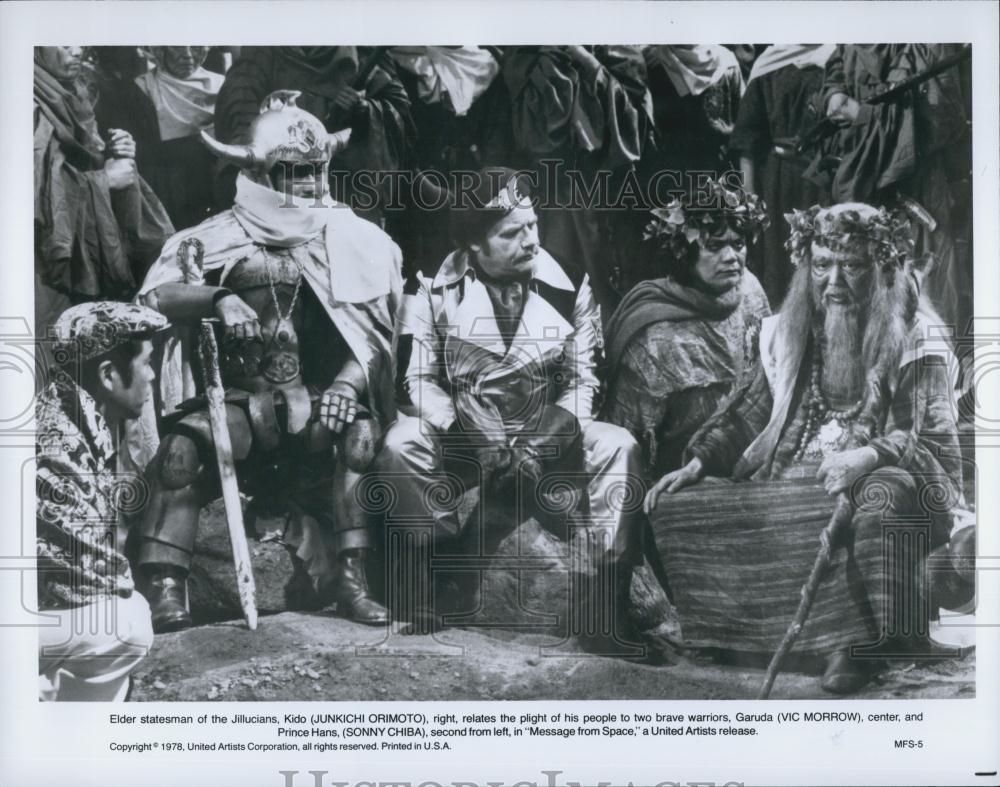 Morrow had starred in the 1960s tv series Combat and was the coach of the rival team in The Bad News Bears (who hits his son, in front of the crowd). Morrow's career was somewhat stalled in this period; he was doing tv movies and guest appearances and lower budget films. He was brought in to be a combination Ben Kenobi and Han Solo. The film can't compare to ILM's special effects; but, they were pretty good, for the period, as Toei had a good effects department. They would go on to produce the Star Wolf tv series, which provided the two films, edited from episode footage, that became MST3K favorites Fugitive Alien I & II. The princess of the attacked tribe travels in a sailing vessel, in space, while other ship designs reflected the Star Wars designs and military aircraft style. Japan had a background in space opera, particularly the manga work of Leiji Matsumoto. Matsumoto created Space Battleship Yamato, in 1974, about a starship that goes on a quest to obtain an alien device to save the population of Earth from radiation poisoning, after an alien bombardment. This was soon followed by Space Pirate Captain Harlock (title pretty much covers it) and Galaxy Express 999. Around the time of Star Wars' release, the Yamato series was edited into a feature film... Ironically, when Sandy Frank picked up the series for US distribution, the names were changed to more reflect Star Wars, as young hero Sasumu Kodai becomes Derek Wildstar. The Yamato is renamed the Argo. Prior to this, the superhero animated series Science Ninja Team Gatchaman was redubbed and edited into Battle of the Planets, reflecting Star Wars, also adding a robot narrator to cover edits for violence (7Zark7). The original series was set on Earth; but, the BOTP version has Zark narrating taht events occur on other planets and there is stock footage of a light going through a starfield, which is supposed to be the team's ship, the Phoenix. Gatchaman first appeared on Japanese tv in 1972 and a movie hit theaters in 1978 (edited footage of key episodes, plus a new prologue), in advance of the launch of a new sequel tv series, Gatchaman II (later to be part of Saban's Eagle Riders). Next was Italy, with the Italian production Starcrash... The film was shot in Italy, with an international cast, that included Americans Marjoe Gortner and David Hasselhoff, Brit Caroline Munro, and Canadian Christopher Plummer, who was slumming even more than Vic Morrow had been. Italy had a history with sci-fi, from the Gamma One films of Antonio Margheriti (Wild, Wild Planet; War of the Planets, War Between the Planets and Snow Devils) to Barbarella. Writer/director Luigi Cozzi claimed conception of the story before Star Wars; but, the plot mirrors it heavily. Gortner and Munro are a pair of space criminals who get arrested and recruited to aid the Emperor (Plummer) to stop Count Zarth, who has a massive weapon hidden somewhere, and find the other two survivors of a ship attacked by Zarth, one of whom is the Emperor's son (Hasselhoff). Plummer is essentially Princess Leia, relaying the message that drives the heroes, while also serving as the Rebel leaders/Bail Organa. Munro's Stella Star is a mix of Han Solo and Barbarella, a pirate and criminal, in a sexy package (Barbarella was a secret agent). Gortner is her sidekick, a mixture of Luke and Chewie (as sidekick/co-pilot). Of course, he gets a laser sword, while Stella has a blaster rifle. Hasselhoff's prince is a bit of Leia and Luke. Nothing is a direct copy; but, the DNA is mixed across chaarcters. Zarth is full villain and his soldiers are armored goons and ships are meant to invoke Star Wars. Acting is universally bad and/or over-the-top. Munro was always a pretty face and great body, with little acting skill and Gortner had been a child evangelist who went into acting (as even he says there was little difference) as an adult, with modest success. Gortner was never subtle. Hasselhoff was relatively young and not quite up to later cheesy, but entertaining standards. Plummer plays it loke theater but looks embarrassed to be there. He did the film for a free trip to Rome. The film was done for American International Pictures; but they declined to release it and it was picked up by Roger Corman's New World It made the rounds of drive-ins and small theaters and got horrible reviews; but, with the hunger for sci-fi; and, with a $4 million budget, made money. However, audiences tended to laugh at it more than cheer it. It was notorious for some years and eventually ended up as a feature for the newly revived MST3K, on Netflix. Canada joined the parade in 1979 with HG Wells' The Shape of Things to Come. The title (the bit after HG Wells') was the title of Wells' novel of a future with perpetual war, that leads to a groupof scientists and airmen to establish a dictatorship to save mankind, which was the basis for the 1936 sci-fi classic Things to Come, from William Cameron Menzies. The only part of the novel to make it into the film was the character name John Cabal. The film is in a future, where most of Earth's population lives on the Moon, in the domed city New washington. They need an anti-radiation drug, manufactured on the planet delta 3. A consignment arrives on a ship, which crashes into New Washington, causing massive destruction. the crash was caused by Omus, the Robto master, who demands to be recognized as the ruler of New Washington. Cabal and his son launch a spaceship to stop Omus and his robots. The premise has nothing to do with Wells; but, it also isn't a Star Wars clone. It has some similarity with Battlestar Galactica, which premiered in 1978. John Cabal is played by Barry Morse, who was appearing in the Gerry Anderson tv show, Space 1999, seen in syndication in the US. Jack Palance, who was mostly working in Europe, is Omus, a former student of Cabal (Kenobi/Vader relationship). Nicholas Campbell (Canadian actor with minor roles in A BridgeToo Far and The Spy Who Loved Me) is Jason Cabal, the young hero and Anne-Marie Martin (Buck Rogers, Sledge Hammer) is Kim Smedley (love interest). Carol Lynley (ton of 70s tv) is Nikki, leader of the resistance on Delta 3 and John Ireland plays Kim's father, a senator. The film is made on the cheap and is just plain terrible. Everything, from acting to sets, to special effects just looks cheap, is badly shot, over-acted and just makes you want to stop watching. Star Carsh has a certain train-wreck charm, this one is just one to watch if you are curious about space opera films in the wake of Star Wars. Both Buck Rogers and Flash Gordon got their time at the movies, after previously being adapted into movie serials. Buck was actually the pilot movie for the tv series; but, the footage looked good enough and a film version was created and sent to theaters, before the tv series premiered. 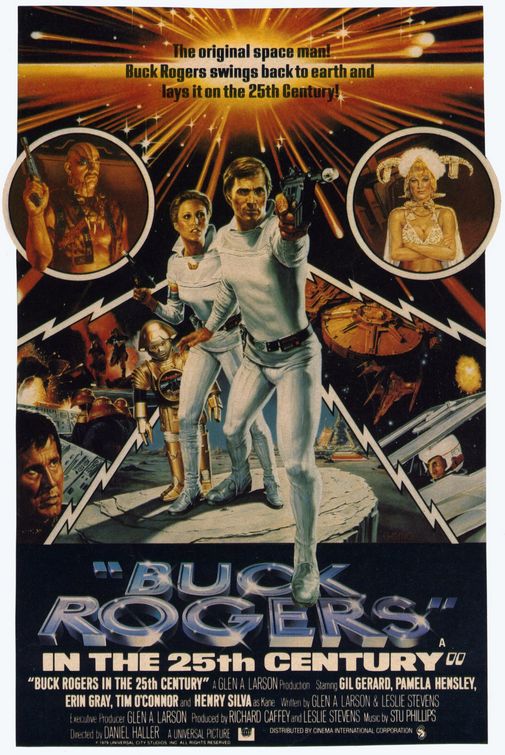 Flash Gordon would come from Barbarella producer Dino De Laurentiis, who beat George Lucas to the punch. the film starred unknown Sam Jones, Melody Anderson, Max Von Sydow, Timothy Dalton, Brian Blessed, Peter Wyngarde and Ornella Muti. Buck was played a bit more straight, with an occasional twinkle in the eye (not as much in the tv series) and the film was quite entertaining. The tv version had some slight alterations. In the film, Buck goes off on his own, outside the domed city, to explore Old Chicago. He is soon sentenced to death as a spy; but, gets a stay of execution to try to prove his story when the Earth forces meet the Draconia. In the tv version, he is tried as a spy and exiled to the ruins of Chicago, then brought back. The end of the tv broadcast has him in a new apartment, where he turns down an offer to resume his career with the Earth Defense Directorate. The film ends with Buck & Wilma and the Earth ships defeating the Draconians, Wilma rescuing Buck and Twiki from the Draconia before it explodes, and Ardala and Kane escaping in her launch. Flash was played more as camp, as was Barbarella. It's never quite as overt as Barbarella; but, is so over-the-top that the effect is the same. Strong performances by dalton and Sydow keep it from degenerating into pantomime; but, Blessed chews more scenery than he did in Black Adder (and that was a lot!). Blessed became an icon because of his broad performance and line delivery... The man is barking mad! So, how about a pretty good one that kind of slipped in there? Cameron was itching to get in on Star wars action, especially after Star Crash made him some money, despite its badness. So, he spent $2 million (much of it for George peppard and Robert Vaughn) and had a bunch of promising young people work on it in his Van Nuys studio. Gale Ann Hurd was Assistant Production Manager, John Sayles wrote the script, Jimmy T Murakami directed, James Cameron handled models and special effects. James Horner provided the music. The film stars Richard Thomas (John Boy, of The Waltons) as Shad, of the planet Akir (named after Akira Kurosawa) which is threatened by the evil conqueror Sador (John Saxon), who has a superweapon in his massive spaceship. Shad flies the Corsair ship of Zed (Jeff Corey) , the only Akir to have been in battle, with the ship's AI computer Nell. They head to the space station of Dr Hephaestus (Sam Jaffe) to get weapons. The doc wants him to mate with his daughter Nanelia (Darlen Fluegel). She helps him escape and brings an analyzer that will help them plan a defense. Shad meets up with gunfighter Gelt, who lives alone, on a former casino settlement. Gelt agrees, in attempt to find some peace. The Valkir, St Exmin (Sybil Danning) turns up challenging Zed, then offers her help. Shad runs into Cowboy (Pepaprd) a space trucker with a load of weapons and Nanelia meets up with Cayman, a lizard alien with a grudge against Sador, and the Kelvin, a group of beings that communicate through heat. Finally, Shad encounters a clonal race, Nestor. Together, they help coordinate the fight against Sador and his forces. The effects were pretty good, for the budget and the young filmmakers are creative in shooting things. The actors play it straight and the story (Seven samurai, by way of The Magnificent Seven) is strong enough to support things. There are various nods to things, such as Vaughn playing essentially the same character as in The Magnificent Seven and St Exmin's outfit, which looks like hands clutching at her breasts, before she changes it for a leather and spandex number, with cut-outs. Cowboy is from Earth and loves westerns, carries a harmonica, and plays up the western cliches. Zed's ship has breasts, though from some angles it looks like a scrotum. The film did well enough at the box office, despite mixed reviews and even better on cable and video. Corman reused some of the footage in the film Star Raiders. Cameron would go on to direct Piranha 2 for Corman, before moving on to terminator, with Gale Ann Hurd as his wife and producer (before they split). Sayles went on to his own writing and directing career and Horner was in great demand for film scores, in light of this and Star Trek.   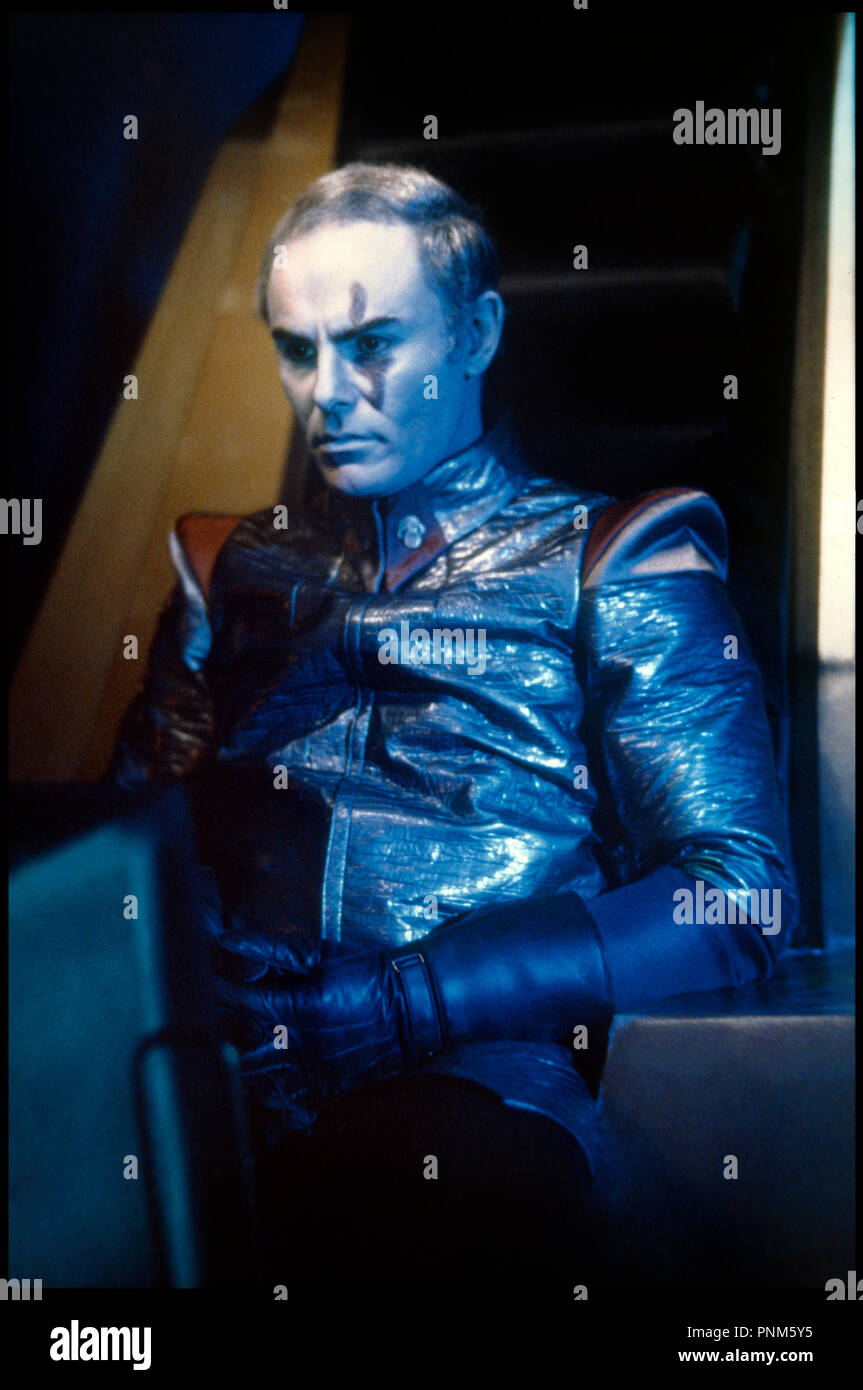  Next time, another Corman sci-fi film, with plenty of action, some name stars and a ton of social commentary and black humor. Come on back for Death Race 2000 and see pro wrestling, with cars. |
|
|
|
Post by codystarbuck on Apr 23, 2020 19:56:07 GMT -5
The 1970s were a period of change in Hollywood. The old studios were being sold off to conglomerates, independent production companies were becoming the norm, a new wave of young writers and directors were making a big splash. Not too long before, the Hayes Code had been dumped and a new ratings system implemented, with filmmakers pushing the edge of what was acceptable on scree. The upheaval of the 60s, with protest marches, assassinations and waras around the globe (colonial and civila wars raged in Africa and the Middle East, while the US was embroiled in the Vietnam War. Film and tv were beginning to reflect that more violent and cynical outlook. The 1972 Munich Olympics was marred by a terrorist attack that left 11 Israeli athletes dead, after a prolonged hostage siege and botched attempt to stop the terrorists. At the movies, this world of violence, cynicism, creative freedom and sports as a metaphor for the breads and circuses of Rome led to a couple of notable films from the same timeframe. One was a major studio prestige film, the other a quick knockoff for the drive-in and grindhouse circuit, from a low budget producer. The one spawned the other and both proved to be excellent, in their own right. The first film is Rollerball, directed by Norman Jewison. The film was based on a short story, "The Roller Ball Murder," by William Neal Harrison. Harrisonerote the screenplay, expanding the short story he wrote for Esquire Magazine, about a future world where corproations replaced nations and everyone worked for one of them: Energy, Food, Transportation, Housing, Services, Luxury. Executives are the elite, living as a law unto themselves, with fancy homes and luxuries. Everyone else works for the conglomerate. Their chief entertainment is the sport of Rollerball. The game has a metal sphere fired by a pneumatic cannon, onto a banked oval track, where it is picked up and carried forward towards a goal. The team members ride on skates or motorcycles (there were runners with lacross sticks, in the short story) and the game is known for its danger and violence. The star of this sport is Jonathan E, a man unsurpassed in skill. The film stars James Caan as Jonathan E, the Michael Jordan of Rollerball. John Houseman is the head of the Energy Corporation, which owns the Houston team (it grew out of the oil companies). Shane Rimmer is the team coach, John Beck is Moonpie (a teammate of Jonathan), Maud Adams is Jonathan's wife, taken away by a corporate executive. Moses Gunn is Jonathan's trainer. Jonathan excels in a sport where individual action is supposed to be futile and the conglomerates are frustrated by his continued dominance, giving the workers a hero beyond the corporate executives. They conspire to change the rules, make the game more and more vioent, culminating in a match with no penalties, no substitutions and no time limit. In essence, it is a fight to the death and designed to bring about Jonathan's. The film is filled with social commentary, as the workers live small lives, subservient to the will of executives. The have no power; if they possess something an executive wants, it is taken away. There is no upward movement, no rewards. Corporations replaced nations and are the sole law. What they decide..... is. As the top player, of the top team, Jonathan lives a life of luxury: fine house, cars and a private helicopter, priovate training facilities, a string of girlfriends to replace his lost wife. But it all seems hollow. he is being pressured to retire; but he isn't ready. He wants to know more about how this society came about but knowledge is hidden away, lest a lowly worker get ideas above their station. Jonathan is offered rewards and temptations and turns them down. His teammates are tempted, to distract them, make them less effective and make Jonathan more vulnerable. They try to influence hi with the offer of his former wife, though he sees through it and how hollow she sounds. He sends her away and erases the images he had of her. They kill his buddy Moonpie. Jonathan fights on. They rig the game so he can't win and it is a free-for-all of death and destruction, yet he stands tall. The film was shot in Munich, on the Olympic cycling track and makes great use of the modern buildings in the area, as well as in Houston and other spots to give this the feel of tomorrow. We see a foreshadowing of corporate dominance of life and their usurping the powers of government. This is ancient Rome in the corporate today. This is the NFL, with rules stripped away. It's roller derby, but the fix is in how the game is played, not who will win. It's the Ben Hur chariot race, on skates and mini-bikes. Jewison films it with great images that capture your attention and fill the screen with metaphor. There are layers of commentary, from dialogue, to fashion, to the actions of people and the world around them. The cast and crew spent time actually playing the game, to the consternation of the director. he was trying to make a statement about how sport is used to distract people from their own exploitation; but his collaborators were distracted by the game. The film was sold as violence on screen, with much of it greatly exaggerated by an increasingly lazy media. It is nowhere near as bloody as things like the Godfather and no more violent than Monday Night Football. The film poster plays up the gladiatorial aspects, with a Robert Peake image of Caan, with spiked gloves...  Here's the reality...  The final bout is very violent; but, there is a reason for it, as the corporations are trying to kill Jonathan; but, he is a warrior and he fights his way through. There is nothing gratuitous about it, compared to your average slasher film or action movie. Rollerball was a big success and others wanted to duplicate it. One of those others was Roger Corman. He optioned a different short story, "The Racer," by Ib Melchior. He hired Robert Thom to write it and Paul Bartel to direct it. Bartel wasn't happy with the script and Charles B Griffith was brought in to fix it, with Bartel adding comedic touches. The premise of the film is another violent, bleak future, where a repressive state distracts the populace with a cross country race, where points are scored by running over people. The younger and more vital they are, the higher the points. The racers all have gimmick personas, rather like professional wrestling personal;ities: Nero the Hero, Matilda the Hun, Calamity Jane, Machine Gun Joe Viturbo and the champion, Frankenstein. A resistance movement seeks to sabotage the race and wants to get close enough to assassinate the president, who presents the trophy to the winner. Frankenstein is a mish-mash of parts, due to injuries from wrecks. His mechanic turns out to be the niece of Thomasina Payne, leader of the rebels. Corman intended for Peter Fonda to star; but, he was unavailable and David Carradine was signed, for 10% of the gross. Only Carradine and Ron Howard ever got points in a Corman film. Carradine was in the middle of his success in the tv series Kung Fu and had to finish filming it, first. The rest of the racers included a relatively unknown Sylvester Stallone (which was about to change, the following year, with Rocky), Mary Woronov, Fred "Gopher" Grandy and Martin Kove (Kreese, in Karate Kid and Cobra Kai). The race is covered by a trio of reporters: the bombastic, enthusiastic Junior Bruce (Don Steele), tabloid reporter of gossip and sex Grace Pander (Joyce Jameson, of Outlaw Josey Wales and numerous films and tv shows) and Howard Cosell-like Harold (Carle Benson) who adds technical detail and history to the race. The film is a treasure trove of cartoon violence, pro wrestling gimmicks in cars, and really black humor. At the start of the race, the residents of an old eprson's hospital and parked out front to be run down an euthenized, but Frankenstein swerves around them and slams through the medical staff of the hospital, scoring points on them. Machine Guin Joe Viturbo;s car has a giant knife jutting out from the hood and he runs down a man and the knife slices him up the crotch (with very red pain-looking blood). The cars were custom built and things of thematic beauty... 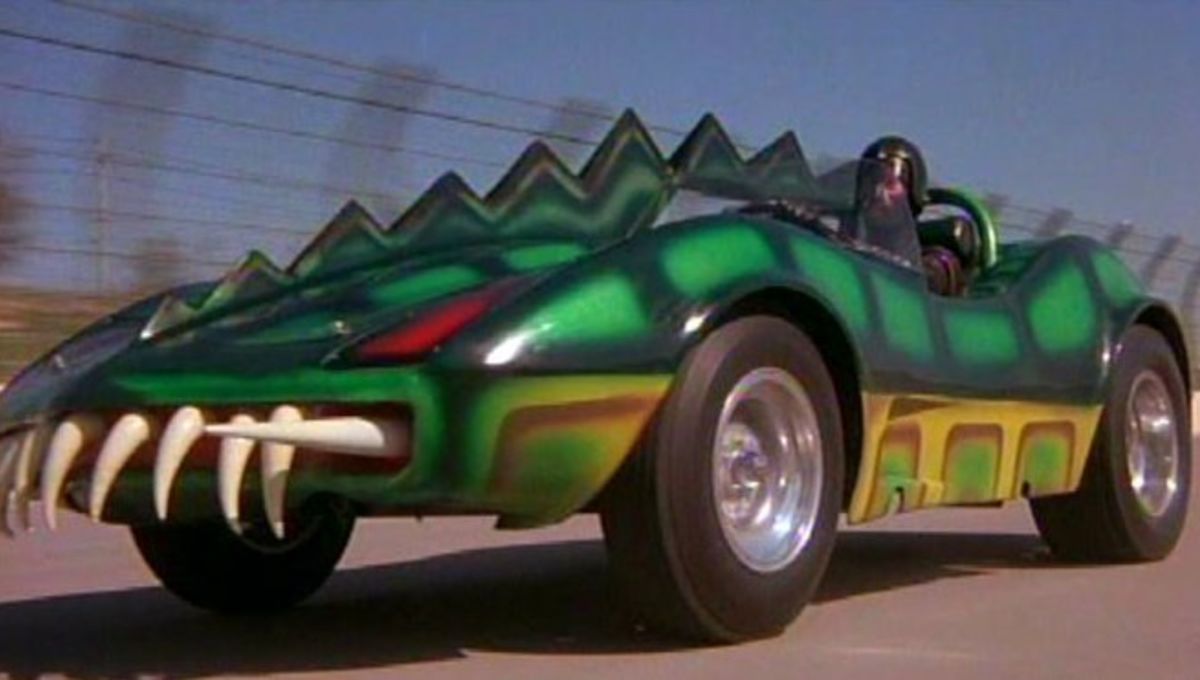  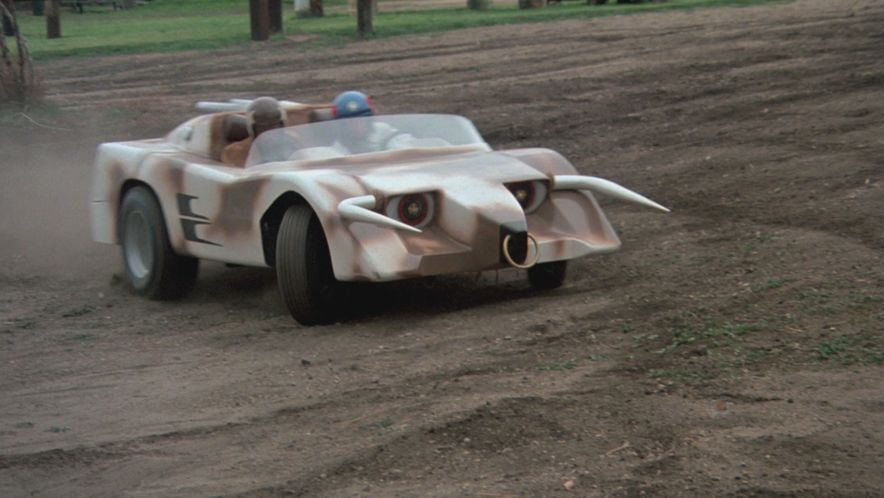  Corman was no fool and took the cars on a tour of the country, promoting the film, earning back the production costs to build them. The films is filled with dark humor, from Frankenstein's "hand grenade," to the over-the-top hyperbole of the race commentary, the road runner and coyote attacks on Frankenstein, to the rebel group. Frankenstein turns up to be an orphan who was raised by the state to race as Frankenstein; one of many. When one is killed, another replaces him. The film was notorious for the cartoon violence, some nudity and the dark humor that matched the cynicism of the 70s. A sequel was inevitable, but took a few years to emerge, in Deathsport... Carradine is back, with Richard Lynch as (what else) the villain. Claudia Jennings was there for the T & A; but the film was a trainwreck. The script was bad and Corman couldn't find any takers to fix it and dumped it on a fresh-out-of-film school Nicholas Niciphor, who was quickly in over his head and the film is credited to him, Allan Arkush and Corman. Carardine was toked to the gills and a pain in the asphalt to the director and Jennings had serious cocaine and alcohol problems. Carradine assaulted the director and those were the highlights. The film lacks the humor of Death Race 2000 and the cast of talented actors as you get Lynch's same old performance and Carradine under the influence. The film came and went. Both Rollerball and Death Sport got mixed reviews, at the time; but became cult classics and re-evaluated later. A lot of what was in Rollerball came to pass, while Death Race is seen as more of a dark comedy than the gory, violent film it was condemned as. Death Race would spawn a tepid remake (which did well enough for a sequel) and a short-lived comic series, Death Race 2020, where Frankenstein is forced to revive the race, as the country is falling apart, under his rule. The creative team was Pat Mills and Kevin O'Neil, of Marshal Law fame (a good choice); but, was undermined by the Speculator Bust and a flooded market. Next, we compare a pair of smart guy paranoid thrillers, with Three Days of the Condor and F/X. |
|
|
|
Post by codystarbuck on Apr 24, 2020 19:31:08 GMT -5
In 1974, in the wake of the Watergate revelations, Richard Nixon resigned the presidency of the United States. It was possibly the last stage in a progression of the loss of faith in the government. The previous decade had seen the assassination of the president, his brother (a presidential candidate), Martin Luther King, the fracturing of the nation over the Vietnam War, the revelations of the Pentagon Papers and the Watergate break-in and subsequent hearing where it was revealed that the White house was tied into the break-in. The CIA had been exposed as being involved in hairbrained and dangerous operations, not to mention subversion of friendly and democratic governments. It was a cynical and paranoid time. During that time, a novel was written, about a man who reads books for the CIA, looking at plots of thriller novels to be logged for potential use in operations or in uncovering enemy operations. He goes to lunch and returns to find all of his colleagues killed in a professional hit. he goes on the run and calls in to his superiors. Something isn't right. People try to kill him. He takes a woman at gunpoint and hides out at her place, while he tries to sort things out. In the novel, this occurs over 6 days. Movies don't have that kind of attention span; so, Sidney Pollack had it all occur in 3 days...
Robert Redford stars as Joseph Turner, the reader who escapes the hit, while Cliff Robertson is his superior, trying to bring him in. Max Von Syow is the calm professional who carried out the hit and Faye Dunaway is the innocent woman who gets pulled into things.
At first glance, this would seem an odd film for Redford, the pretty boy actor who played a romantic lead. Well, in the 70s, he was busy proving that the pretty boy could act (and direct, eventually) and this shows it quite well. Joseph Turner seems an ordinary guy in a strange job, reading books and writing up summaries of the plots for CIA computers. He doesn't really consider what his work is used for; he just does it. He is in love with a co-worker, is a bit anti-authority, as he flirts with the rules. He sneaks out a back way instead of checking out at a reception desk, when he goes to lunch. That saves his life, as the hit men have no record that he is missing. That gives him time to go on the run, after he sees their handiwork.
This wasn't James Bond spy stuff; no tuxedos, no cocktails and high end sports cars, no grandiose schemes to rule the world; just an ordinary guy in an extraordinary situation, who soon finds that he can't trust his own bosses. Turner isn't and "Average Joe," though; he is highly intelligent, reads a variety of material and retains much of it. He solves problems, makes decisions quickly, thinks quickly. He spots inconsistencies rapidly and his anti-authority streak means he doesn't follow established rules. This keeps him alive.
Faye Dunaway is forced into helping him, then is won over by him. She's a sad woman in a failing relationship. His intrusion saves her from further heartbreak and forces her to face life. She proves to be a pretty tough cookie, when push comes to shove. Cliff Robertson is the man caught up in cleaning up a mess and sorting through things. He doesn't trust Condor and he also knows that someone is running their own operation within the Company. He sets other players in motion. John Houseman is a senior officer who wants it all buried away, where no one will find the grave. Von Sydow is a quiet, uanassuming man who could kill you a dozen ways before you ever considered that his smile wasn't just polite European manners. He has no stake in things; he's just a professional, doing his job. He doesn't care about politics, though he does provide Cond with the best advice he receives.
The film is a piece of classic cinema, paranoid for good reason, extremely well written and performed, filmed by professionals and craftsmen. It captures New York well, weaves in and out of circles of power and the stomping grounds of the ordinary folk.
The original novel was just a what if exercise, after the writer saw a placard on a non-descript building and started day-dreaming, asking himself what if that non-descript office was actually a front for the CIA? The movie has more of a political agenda as it dwells in the turmoil of Watergate and CIA dirty tricks. Condor comes to find out what the CIA does with the fiction he reads and the kind of games it plays and what consequences those games have for innocent people.
What the film really does well is depict an intelligent man using his brains to solve problems and get himself out of a dangerous situation. At every turn, the CIA people trying to get to Condor, to aid or to kill, underestimate him. he's not a field agent; but he is able to elude trained killers. He uses telephone equipment to find intel and throw off his pursuers. He is more than a personnel file would indicate because of the prejudices of those who assembled the file. Bond and his cohorts are blunt weapons used to stop mad villains; Condor is a man with a brain, faced with a seemingly impossible problem, who sets out to work the problem. This was rare in the 70s and it is extremely rare in modern film.
Several years down the road, we got another thriller that dealt with an intelligent man who applied his skills to create illusions for movies. He gets caught up in a conspiracy and has to use his brains and his talent to get himself out of danger. That film was F/X.
Bryan Brown (Breaker Morant, The Thornbirds) is Rollie Tyler, a special effects man for various horror and action films He is hired by a pair of Justice Department agents to stage a fake assassination of a mobster who is set to testify against the mob (played by Jerry Orbach). He carries out the plan, using blood packets, squibs and a blank gun; but, one of the agents tries to kill him. he survives, contacts the other agent and is nearly kileld again. he goes into hiding at his girlfriend's apartment and thinks he is safe and going to go to the police and news media, when the girlfriend Diane Venora, of Heat) is shot by a sniper. The man comes into the apartment to check on his work and Rollie attacks him from hiding, barely escaping with his life. he goes on the run again. meanwhile, a New York cop (Brian Dennehy) is investigating the murder of the girlfriend and things don't add up. He's been hunting the mobster and when he finds out about the Justice Department, he starts sniffing around unofficially, until he is suspended. However, that doesn't stop him and he lifts his bosses badge and goes hunting. Rollie gets in touch with his assistant and then starts turning the tables on the people hunting him, using his effects wizardry and equipment. He eventually traces the man who hired him and learns why, while playing cat and mouse with his bodyguards.
Like Condor, this is a thinking man's thriller. Rollie is not some beefed up agent or cop; he's a guy who mixes fake blood and makes it ooze out of bodies that explode with squibs. However, the people who hired him underestimate his resourcefulness and ability to improvise things. He's also used to illusion and he uses their arrogance to set them on wild goose chases. At one point, he calls the crooked agents, who try to trace the call and learn it is coming from their building's lobby. The accomplice runs down to catch Rollie and finds that he has taped the receivers of two pay phones together and is calling from another location, through them, watching them from a distance.
Denenhy is also a shrewd cop who doesn't buy into the obvious because he spots the flaws. He goes looking in places people are ignoring. Even when he is suspended, he fakes out his boss. he is able to track the crooked agents on his own, eventually meeting up with Rollie and surprising him.
brown was a bit of an unsung actor, in Hollywood. He got a few high profile parts and some lesser things, after working with the likes of Bruce Beresford, Simon Wincer, Philip Noyce and Tom Jeffrey. he was mostly used in supporting roles, in Hollywood, with this being one of his better lead roles. He nails the confusion, the professional skill and the emotional level well, as he must deal in loss, excitement, danger and anxiety in equal measures. Dennehy was a terrific character actor who kept going from interesting part to interesting part, often grounding preposterous premises (like this one) with believable humanity. Both he and Brown were theatrically trained and they work well together, when they do meet up. Diane Vera gets to have fun playing an actress. He opening scene has her as a stunning blond, who gets gunned down in a mafia hit, that is part of a movie being filmed. She is playful and loving with Rollie and, when she hears he is being hired to stage something, her first instinct is to ask if there is a part for her in it. A true actress! Cliff De Young is Lipton, the young agent who is a fan of Rollie's movies, yet never comes across as trustworthy. His boss, Mason, is played by character actor Mason Adams, best known as the voice of Smuckers jam and jelly ads. Dennehy's boss is played by Roscoe Orman, better known as Gordon, on Sesame Street (3rd actor to play him, starting in 1974), which everyone in the theater I was in spotted immediately. That's really what makes this film great; it's filled with character actors, giving life to the plot. Too many films these days ignore character roles to make what are glorified cameos.
F/X does take some willing suspension of disbelief and logic; but, it still is driven by a smart, capable man, trying to work his way out of a desperate situation. Like Condor, the people hunting him underestimate him and he proves smarter than they are.
Next, we head back in time for a bit and look at the cinematic exploits of a hero of the Old West. Come on back as we cue up some Rossini and thrill to the days of yesteryear, as a fiery horse kicks up a cloud of dust and a booming voice cries out "Hi-yo Silver!"
|
|
|
|
Post by codystarbuck on Apr 25, 2020 23:03:05 GMT -5
In the early days of the western United States, a masked man and an Indian rode the plains, searching for truth and justice. Return with us now to those thrilling days of yesteryear, when from out of the past come the thundering hoofbeats of the great horse Silver! The Lone Ranger rides again! Never was there a more perfecting melding of hero and music, even if the music was meant for a different hero (William Tell). For at least 2 or 3 generations of people, if you asked them to name a western hero, chances are pretty high that most of them would say The Lone Ranger. 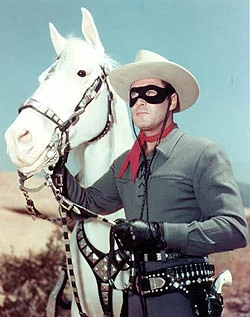 The Lone Ranger was born on January 31, 1933 (possibly a day or two earlier, though there is no proof). George Trendel, owner of Detroit radio station WXYZ, was tired of paying for outside programming, at what he felt were high rates. He decided to commission his own shows and a writer, Fran Striker (with Trendle's input) came up with a doozie. Texas Ranger Captain Dan Reid and his party were led into an ambush, carried out by The Cavendish Gang. All six men appear dead. A young Native American comes across the carnage and finds that one man still lives. He treats his wounds and cares for him, until he is strong enough to ride. He makes a vow to bring the Cavendish Gang to justice and to hide his identity and make everyone think that the Rangers all died, he dons a mask, fashioned out of the vest of his dead brother, Dan Reid, and the lone surviving Ranger begins his quest for justice. he acquires a beautiful and spirited white stallion, which he names Silver and is accompanied by his friend, Tonto and the ride in search of the Cavendish Gang. After they bring the killers to justice, the man, called Kemo Sabe (trusty scout) by Tonto, continues his quest to aid the downtrodden and distressed people and bring justice to the West. The radio show ran for nearly 3,000 episodes, building the mythos of The Lone Ranger and Tonto. It is never stated what his name is, though he was later given the name John Reid,. His own sond, John Jr, would go on to have a son, Britt, who would be a crusading newspaper publisher and secretly the hero, The Green Hornet, bringing justice to criminals, with the aid of his partner, Kato. The Lone Ranger became massively popular and was soon headlining the Mutual Broadcasting Network, then the NBC Blue Network (which became ABC). He appeared in books and comics and would soon emerge on the screen, in two serials from Republic Studios.... 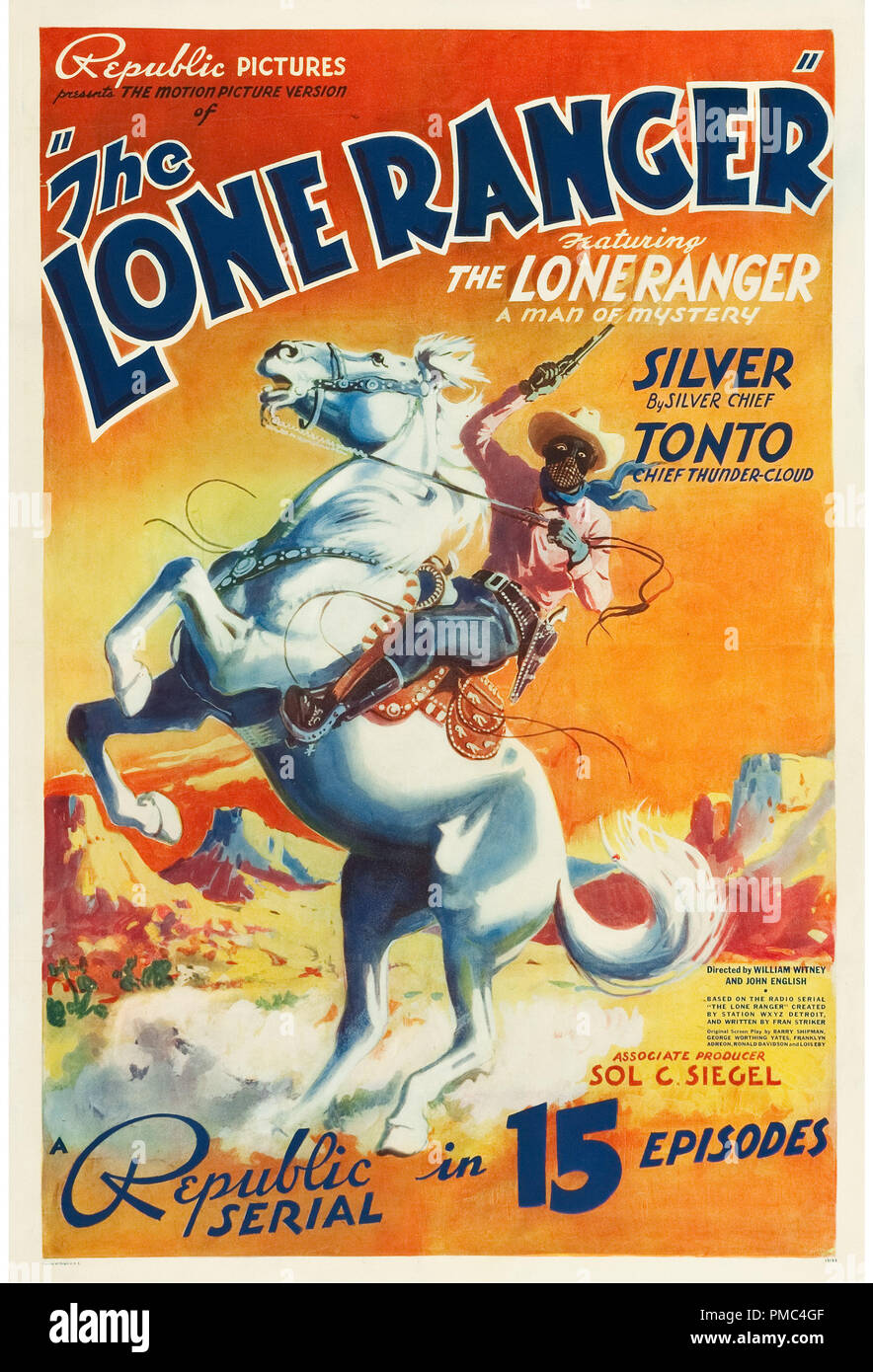  In the first serial, Confederate Army deserter Capt. mark Smith leads a band of other deserters into Texas, seeking to take over the whole state. They capture the new FinanceCommissioner and Smith replaces him, with his outlaws operating as his troopers, collecting taxes off the populace, which go into his own pocket. One of his stoolies, Snead, leads a band of Texas Rangers into an ambush and only one survives, with the aid of Tonto. he becomes the Lone Ranger, fighting the outlaws. He also works with a resistance group and his identity is a mystery through the serial. He is one of 5 men who mat be the Ranger: Allen King, Bob Stuart, Bert Rogers, Dock Forrest or Jim Clark. Smith hunts for the Ranger, while the band of resistance fighters works together to defeat his gang of outlaws. Trendle optioned the property to Republic, but gave away script approval and Republic, as Hollywood is want to do, made changes. They intended to reveal the Ranger at the end, raising objections from Trendle, who couldn't stop it. Also, the Ranger's mask is a bit different. Along with the eye mask, it had a sort of veil, covering his lower face. In some pictures, it is a mesh, in others, it looks like solid cloth or some other material. The serial did well and was the biggest production since Flash Gordon. A sequel followed, which further annoyed Trendle, leading to him ending the partnership with Republic, who would then just rip-off the character for their own masked heroes. Future Tarzan, Herman Brix, appeared as one of the potential Rangers, as did Lee Powell. Chief Thundercloud (born Victor Daniel) was Tonto. Thundercloud claimed to be of several native American groups; but was born in Arizona of Latin parents. It is possible that he have Native ancestry, in Mexico, as his father was from Sonora. Press releases for the serial claimed he was of Muskogee aristocracy; but the Native tribes of the US had no such things. He was an athlete and a cowboy and worked as a stuntman and bit player, before landing the role of Tonto. The sequel finds the Ranger and Tonto helping a group of homesteaders against a gang of raiders. The sequel featured future Cisco Kid Duncan Renaldo in a role, and Yakima Canutt as one of the stuntmen. The film was thought lost, until a print turned up with Spanish subtitles. No further serials of motion pictures appeared, but a tv series was launched, in 1949, starring former Republic stuntman and actor Clayton Moore. Moore had starred in Jesse James Rides Again and was ther male lead in the Perils of Nyoka, as well as playing heavies in several Republic films. He had appeared as Fritz Dorner in Son of Monte Cristo; but, it was a turn in Ghost of Zorro, as the grandson of the original Zorro, fighting a crook out to stop law and order coming to his territory. Clayton Moore was handsome and had a deep commanding voice, but also excelled in the character moments of the Ranger is disguise. Aiding him was Jay Silverheels, an authentic First Nations Mohawk, from Ontario. Together, they became iconic as the Lone Ranger and Tonto. Moore fell in love with the character and did his best to exemplify the Ranger Code... I believe that to have a friend,
a man must be one.
That all men are created equal
and that everyone has within himself
the power to make this a better world.
That God put the firewood there
but that every man
must gather and light it himself.
In being prepared
physically, mentally, and morally
to fight when necessary
for what is right.
That a man should make the most
of what equipment he has.
That 'this government,
of the people, by the people
and for the people'
shall live always.
That men should live by
the rule of what is best
for the greatest number.
That sooner or later...
somewhere...somehow...
we must settle with the world
and make payment for what we have taken.
That all things change but truth,
and that truth alone, lives on forever.
In my Creator, my country, my fellow man.Someone should show this to a certain president (and all members of Congress, for that matter). The popularity of the tv series led to two motion pictures. Mysterious raids by indians riding on saddles has settlers stirred up. A rancher seeks to expand his holdings to include Spirit Mountain, a sacred place to the Native tribes. The Ranger and Tonto aid the governor, Chief Redhawk and others in stopping a war and uncovering the true identities of the raiders, while also rescuing a rancher's daughter. The film captures what was best about the tv series, in color, with a greater stage and beautiful vistas. it also features one hell of a knock down, drag out fight between the Ranger and Angry Horse, played by Michael Ansara... Dammit, that's a hero! Even the Fonz thought so... The movie did big business and a sequel followed... The Lone Ranger and the Lost City of Gold finds a gang of outlaws killing indians to obtain segments of a silver medallion , which has a treasure map to hidden gold. The Ranger and Tonto work to save the last two holders of the segments and stop the outlaws. That would be it for over 20 years, as repeats of the tv series emblazoned Clayton moore as the Ranger on the public consciousness. There was no other. Moore made personal appearances as the Ranger, to large and enthusiastic crowds. In 1966, an animated series appeared, from Format films, done in a similar style to the animated opening of The Wild Wild West, with similar sci-fi and steampunk elements... That was it for a while. Then, in 1981, it was time for the Ranger to return. However, the owner of the property did not live up to the Ranger Code. Rather than embrace Clayton Moore as an ambassador for the Ranger and the film, he got a court injunction, preventing Moore from appearing in the Ranger costume. Moore believed in what the Ranger stood for and was willing to fight for it. he took to appearing in an altered costume and wrap-around sunglasses, adhering to the letter of the injunction, but fighting for the soul of the Ranger.  Jack Wrather, an oil billionaire had the rights and signed with Sir Lew Grade's ITC to create a film, hoping to match the success of the Donner Superman. Like Superman, an unknown would play the Ranger: Klinton Spilsbury. Aside from a few bit parts in soaps, under the name Max Keller, Spilsbury had no acting experience. He endeared himself to the crew by getting into fights and generally acting like a prima donna. The rushes were terrible and he was dubbed by actor James Keach. Native American actor Michael Horse portrayed Tonto, who is shown to have been a childhood friend of John Reid, befriending him after his family is killed by the Cavendish Gang. he lives with the Comanche, learning their ways, until his brother, Texas Ranger Dan Reid comes to collect him and sends him back East, to school. He returns to Texas as an adult, a recent graduate of a university and a lawyer. He is reunited with his brother, then goes with him to catch Butch Cavendish. They are led into an ambush, with only John surviving. Tonto finds him and aids him, until he is strong enough to go after Cavendish, as the Ranger. Christopher Lloyd would portray Cavendish and is the best part of the film, showing him to be a demented madman and sadistic sociopath. he aims big and takes President Ulysses S. Grant (Jason Robards) hostage. Between the bad publicity of publicly attacking a true hero, in the eyes of the public, and a rather lackluster script and poor choice of lead, the film failed at the box office. The film includes an attempt to recreate Yakima Canutt's legendary stunt from Stagecoach (and Zorro's Fighting Legion), where he passes under the speeding stagecoach. Stuntman Terry Leonard did the stunt; but, was badly injured in attempting the stunt, when he was hit by part of the wagon. he attempted the stunt again, in Raiders of the Lost Ark, when Indy passes under the German truck; this time, successfully. I had the novelization of the film and the story was great. It incorporated the key elements of the Ranger mythos, elevated Tonto into more of an equal partner, fleshed out Butch Cavendish, and mixed in historical figures, like Grant, George Custer and Buffalo Bill Cody. However, Spilsbury's line delivery was stilted and odd and was redubbed. His behavior and the box office failure, plus a drunken interview with Andy Warhol sealed his fate and he never acted in film again. The director, William Fraker, also had his career cut short. Michael Horse survived and appeared on Twin Peaks and a few other shows, as well as becoming a noted painter. Christopher Lloyd went on to bigger things with Back to the Future and Who Framed Roger Rabbit?. The shame of it was that it killed interest in a Ranger film or much else for over 20 years. The one bright spot was that the Ranger returned to Saturday morning, with a new cartoon series from Filmation... William Conrad, who had starred as the radio Marshal Dillon, on Gunsmoke, voiced the Ranger, in a perfect melding of voice and character, though you did kind of expect him to mention Rocky and Bullwinkle, at any moment. Like Tarzan, Flash Gordon and Zorro, Filmation used rotoscoping to add to the actions scenes, though the repeated use of the same sequences gave a sameness to the individual cartoons, despite the plots. It did make use of several historical figures. In 2003, a rather coolly received tv pilot movie premiered on the WB, as yet another property was given a youth makeover which failed to capture the essence of the hero. They changed the name and had the Ranger go without the mask day-to-day, acting more like Zorro. No series followed, thankfully. It took a decade; but, a Hollywood desperate for franchises came calling and a new film was developed and released... It came from producer Jerry Bruckheimer, who never met a cliche that he didn't beat into the ground, for Gore Verbinski, yet another music video director given feature film budgets. He had success with the Ring remake and the film Mouse Hunt, though mixed reviews on The Mexican. The Pirates of the Caribbean films snagged him this project and suggested Johnny Depp for Tonto, rather than an actual Native American actor. The film had been in development, since 2002, when it was envisioned as something along the lines of the excellent Mask of Zorro. However, the script didn't wow anyone and it fell into Development Hell, until the writers of the Pirates franchise were brought in. Your mileage may vary, but I find the terms "writers" and "Pirates of the Caribbean" to be opposing entities. As such, i avoided this like the plague. The film ran into bad press over the casting of Depp, who then claimed unsubstantiated Native ancestry on his grandmother's side, which is a favorite old Hollywood story and one often used to try to claim some legitimacy to a legacy of those who were here before the Europeans. Depp at least tried to present authentic Comanche language and there were cultural advisors to the film. Unfortunately, the same effort wasn't spent on a story and most agree that the film starts well and then falls apart, with the train sequence being the visual highlight, despite being a complete CGI fakery and slap in the face to the laws of physics; but, that's modern filmmaking. I've only watched clips and they haven't made me want to sit through it, though Tarantino liked it, noting the weakness of the second act. However, he and I have diverging tastes on many subjects, though I do like many of his films (not so much his potty mouth and attempts to rewrite history to fit his psycho ideas. As I say, your mileage may vary and if you liked it, fair enough. For my money, if you want The lone Ranger, you still can't beat Clayton Moore. Like Superman and Captain America, The Lone Ranger cannot really be done as cynical. You can modernize the story, add nuances to the character, but the public will not accept the Ranger as anything other than a virtuous hero, fighting for justice, no matter how corny it sounds. The truth is, it only sounds corny from the mouths of people who don't believe in what the Ranger stood for; from the mouth of Clayton Moore, it was inspiring. Oh how we could use men like Clayton Moore and the Lone Ranger today! Still, we may not see it in our so-called (fake) leaders; but, his spirit lives on in those who go masked to help others, around the globe, in this troubled time. Next time, we look at another Western hero, who started out as a cold-blooded killer. Come on back for The Cisco Kid (and Pancho). |
|


























.jpg)

















